Different Types of Sailing and Racing Explained
You can literally sail on any type of water: whatever floats your boat. I wanted to know exactly what it's called when crossing an ocean, so I did some research. Here's what I came up with.
What are the different types of sailing? Inland sailing is freshwater sailing, on rivers and lakes. River delta sailing, so in brackish water, is called estuary. Oceanic sailing is divided into coastal (in sight of land), offshore sailing (out of sight of land, but within range), and bluewater sailing (out of sight of land and out of range).
But it's not just your location or the sort of water you're in. Intention also plays a part in determining what kind of sailing you're doing. For example: when does it stop to be offshore, and start to be bluewater sailing? It's a bit of a grey area.
Apart from the type of sailing, you can also participate in all kinds of racing, which I'll go over below as well.
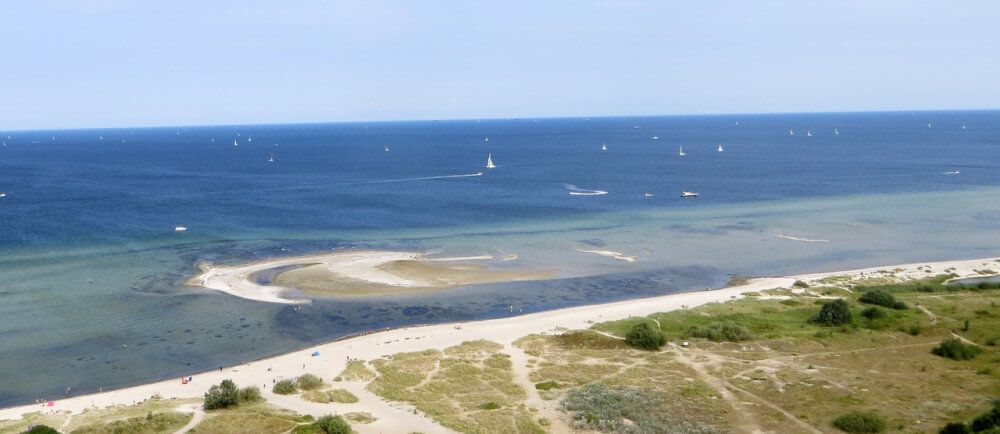

On this page:
More on sailing types, more on racing types, related questions.
There are two types of sailing: cruising and racing (scrolls down ). The most common type of sailing is inland cruising, as most people simply want to enjoy their boats on safe and predictable waters.
There are five different types in total, which depend on where you are and what your intentions are. The further out you go, the more adventurous it gets.
Here are the different types of sailing:
- Inland - best for beginners
- Estuary - rivers that lead to sea
- Coastal - in sight of land
- Off Shore - out of sight of land
- Ocean - blue water or intercontinental
Freshwater generally offers the easiest conditions, and is the easiest on your boat. It's the cheapest and easiest to get started, requires the least amount of equipment and also the least amount of maintenance.
Saltwater generally offers more difficult conditions like stronger winds and higher waves. You need larger and more expensive equipment, and the salt is harder on your gear and boat, so you need to do a lot more maintenance.
The differences between each type of sailing:
Inland sailing
The easiest sailing is on inland waters . All water that is enclosed by land is called inland water. These are lakes, rivers, canals, and so on. Freshwater rivers are pretty safe. In typical lake sailing you won't find yourself drifting for weeks on end because you got hit by a storm. Generally there are more people around that can help you out.
It's important to say that ponds and small lakes can be treacherous. The winds can be unpredictable coming from land (for example due to nearby hills). So these small and seemingly innocent waters may require some real seamanship.
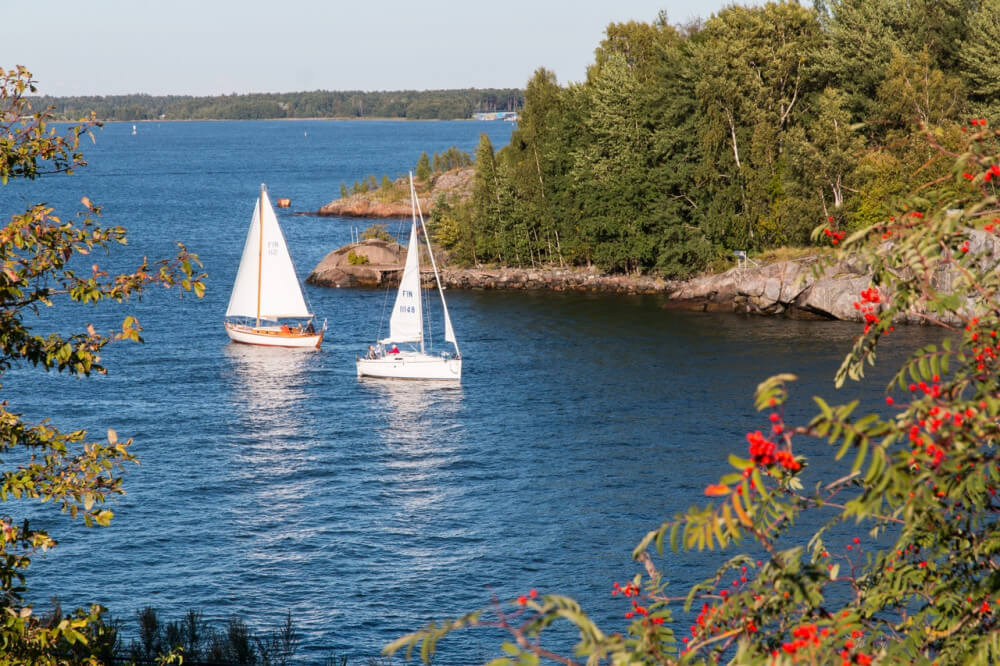
Inland sailing is definitely the best kind of sailing for beginners. You don't have to account for tides, the waves are not as high and you don't have to stock up on supplies since there's always a harbor nearby. It's also the easiest on your boat: inland waters are mostly freshwater, which means maintenance is low.
So great news for beginners on a budget: you can use any boat type: flat bottom, keel, aluminum, wood: whatever you like to sail most.
Estuary sailing
Estuary means the delta or tidal mouth of a river. It's partially enclosed water. Like inland sailing, estuary areas have a lot of oversight. With the Coast Guard keeping a close eye on everybody, the chance that something really bad happens is extremely small. You have to account for some tidal changes and the current can be strong.
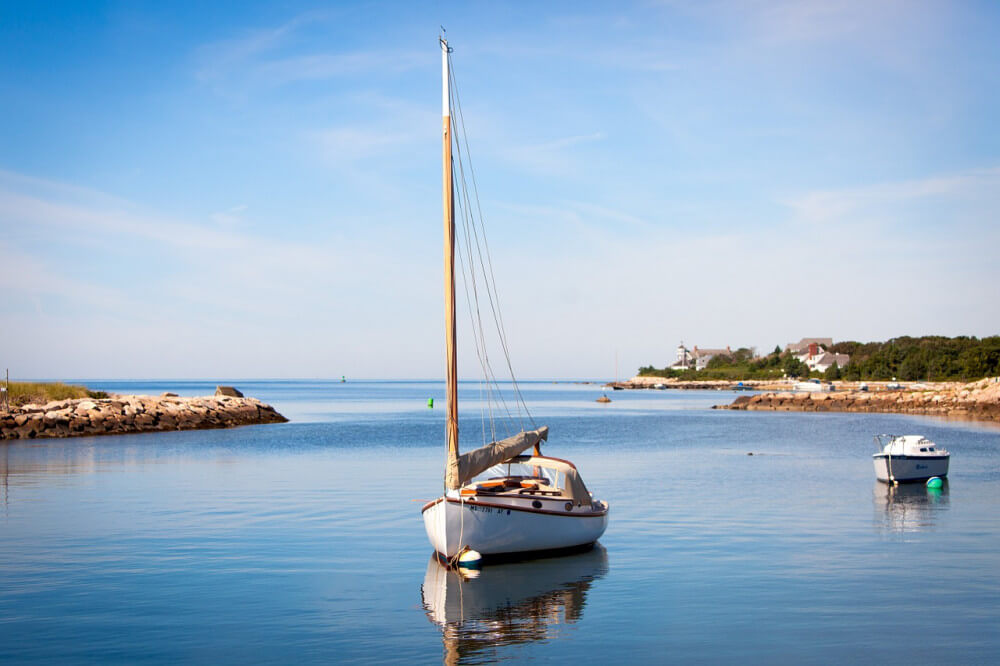
There will typically will be good weather forecasts for river deltas, so there shouldn't be a lot of sudden surprises. However, you want to be prepared in case the weather changes. Maybe you want to have a keel for this type of water, and you should definitely wear a PFD. There are some boats that have a keel you can lower if needed; this way you won't permanently increase your draft, but you'll be able to sail coastal and estuary regions.
Because river delta water is brackish, there's more salt in the water. So it's a bit harder on your boat. You probably need to increase your maintenance. Maybe you want a fiberglass hull, but you probably won't need to convert your entire boat.
Coastal sailing
Coastal sailing is a form of oceanic sailing where you're still in sight of land, but also in partially protected waters. Protected waters are sheltered waters that have stable weather conditions and have Coast Guard support. Mostly, coastal sailing requires a bit more skill and better equipment.
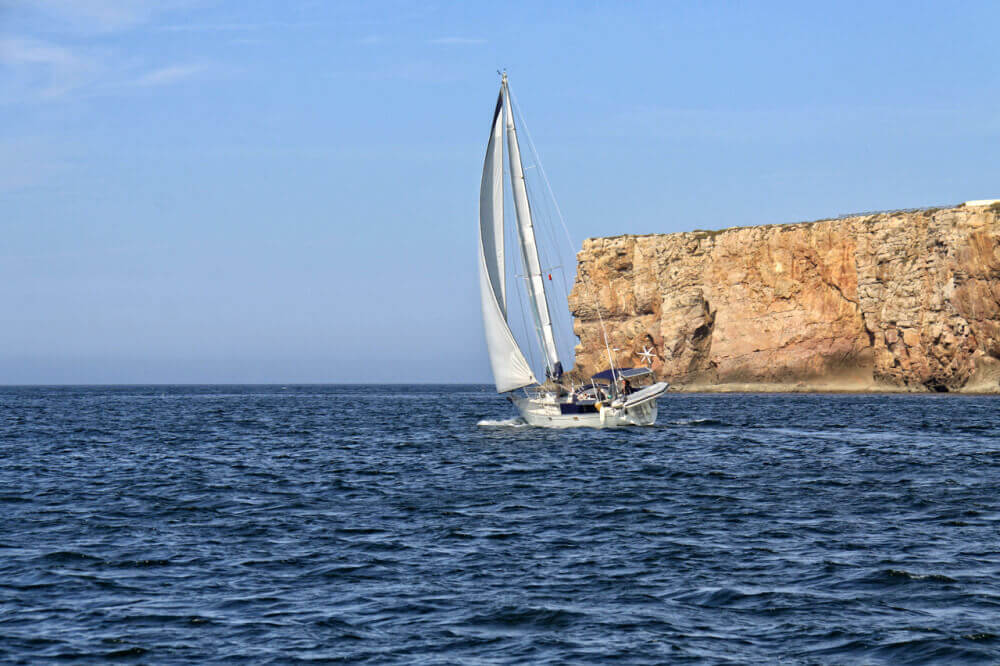
You will need a keelboat to sail coastal waters, and the hull needs to be strong enough to deal with larger waves. The forces you have to deal with are just a level up compared to freshwater conditions. If you go overboard, the consequences can be quite severe, because there can be a strong current, so make sure to wear your PFD.
But, the water is quite shallow and there are reliable weather forecasts. If you don't go out in heavy weather, you'll have enough time to get back to safe harbor when the weather starts to change.
You can use smaller sailboats without problem, but make sure the boat is safe, and you have all necessary safety equipment on board. You may also need to convert your boats engine to help it deal with galvanic corrosion.
If you want to know everything about the systems used in saltwater boats, I really recommend you read my article on boat conversion (opens in new tab ).
Off Shore sailing
You're sailing off shore when you're out of sight of land, but you're not crossing an ocean. Anything under 15 miles of the coast is regarded as off shore, but if you're going out 20 miles and turning back to return for port afterwards, that's still off shore sailing and not bluewater.
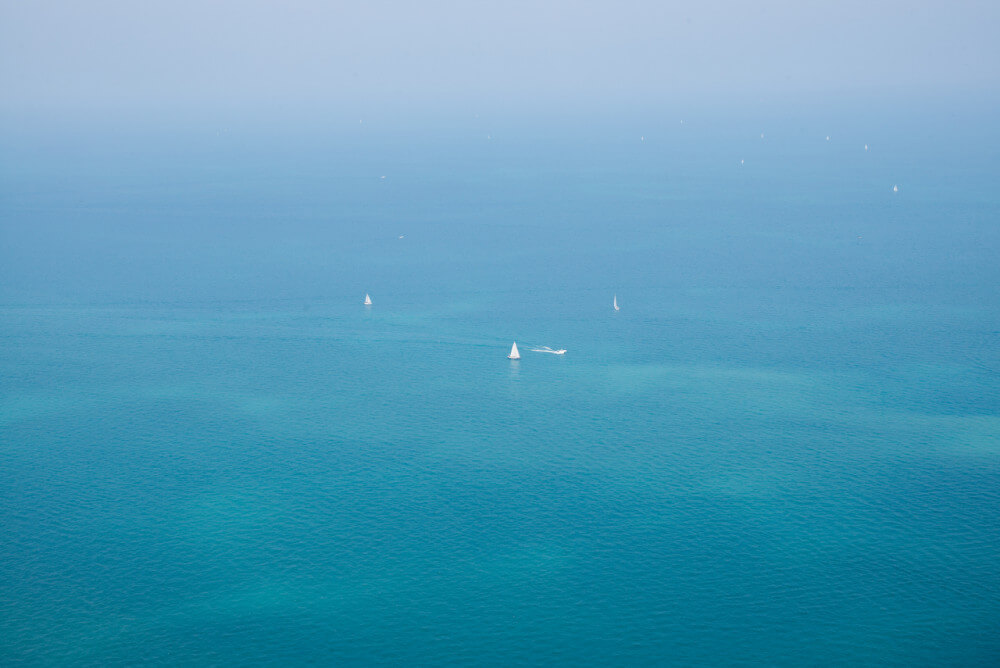
Off shore sailing can be very challenging. Sea conditions can get very rough: the weather gets more unpredictable where land meets water, and the current can get very strong. Generally off shore is more rough than open seas (except for the hurricane season). If you plan on sailing off shore, you definitely need a good strong keel boat that's a bit longer, ideally over 24 - 30 feet (7 - 9 m).
A mistake can have huge consequences. Off shore is being watched pretty closely by the Coast Guard as well, so if something goes wrong, help will be on the way. But it really makes a huge difference whether you're 12 or 20 miles out. Response time for Coast Guard is about 8 minutes at 12 miles, but it's 20 minutes at 20 miles. Drifting around in cold water for 20 minutes can be dangerous. More importantly: they have to find you out there.
So please make sure you have the right safety equipment on board. If you're unsure what you need, check out my post about USCG safety requirements here (opens a new tab ).
Bluewater sailing
Blue water sailing is definitely one of the most advanced types of sailing.
Contrary to popular belief, the open seas aren't always rough. They can be, but it's mostly the off shore areas that suffer from heavy weather. Outside the hurricane season, they're mostly pretty calm. If you use the trade winds, wind conditions are pretty reliable.
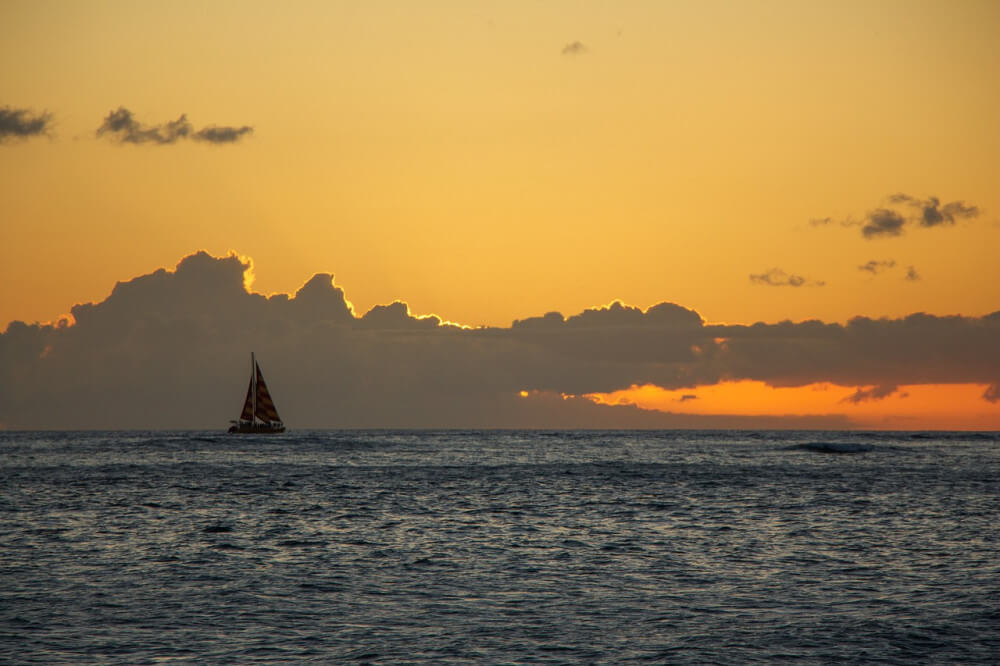
It is recommend to use a mid-sized boat (most sailors go for 30' (9 m) or up), not just for comfort but also to be able to carry enough supplies to last for at least a couple of weeks. Typically you'll need to bring roughly 40 - 60 gallons (200 - 300 liters) of water per person and 60 gallons (250 liters) of fuel.
The hardest part of bluewater sailing is being completely self reliable.
You're out on the open ocean alone, sometimes for multiple weeks on end. The Atlantic crossing takes about three weeks, for example. The longest passage there is about 12 days. During that period, if anything breaks, you need to be able to fix it. If you don't, you won't be able to continue. If something goes wrong - you get injured, for example - you're the one that needs to put on a bandage.
Some people can handle this kind of stress pretty well. Others break down because of it. It's recommended to find out what kind of person you are before getting on that boat and using the trade winds to blast it to the middle of the ocean. Where you hit a dead zone. You're now helplessly floating around in the middle of nothingness on a 100 square foot (10 square meters) piece of plastic. It's just not the best of times to meet your true self.
If you want to learn more about what it takes to do ocean crossings, consider to read my article about bluewater sailing here (opens a new tab ).
Besides cruising, you can also participate in sailing races, which can be great fun. There are a lot of racing types, and you can invent your own rules and competition methods.
The type of race isn't just determined by the kind of water (like with cruising) but also the kind of event, the kind of course, and the competition method (which are the rules and requirements).
Here are the different types of racing styles:
- windward/leeward - racing course with one windward and leeward leg
- passage or course - maneuvering around multiple marks (for example buoys)
- fleet racing - the most common race form where a fleet of sailboats go around a course
- match racing - identical yachts trying to finish first in a single race
- team racing - two sailing teams with multiple boats compete to win a series of races
- one-design - competitive racing at high speeds, based on class requirements: identical models with same rigging and crew
- offshore or oceanic racing - races of multiple days or weeks in open waters over a distance of 800 miles
And this are some different types of racing events:
- twilight racing - social racing events in the summer organized by individual sailors
- club racing - social racing events organized by the local yacht club
- regatta - multiple day event with an overall event winner, typically organized by the class association
- disabled or Para World sailing - official racing events that are organized for disabled people
Competition methods
There are four primary competition methods in sailboat racing: one design and handicap.
- handicap racing - different boats, time gets corrected based on features
- one-design racing - identical boats, real time wins
- formula class - different boats with certain identical features (ie. hull speed)
- development class - different boats that meet specific requirements (ie. length, hull type, etc.)

In handicap racing , time is added or subtracted based on the hull type, materials used, and other design factors. The handicap gets calculated using standardized formulas. So the winner is determined by correcting the time mathematically after the race. In these races you'll see all kinds of boat models, rigging, crews, and so on. The difference between the individual boats makes the handicap.
There are different handicap rating systems. A popular system is PHRF (Performance Handicap Racing Fleet).
In one-design racing , identical boats race for the best time. The first boat to cross the finish line wins. All boats that take part must adhere to the class requirements. So you won't see any different models or hull types in one-design racing. The class requirements determine all kinds of stuff, like the number of crew allowed, the type of rigging, amount of sails, and boat requirements.
There are a couple of other approaches. The development class is a middle way that's right in between handicap and OD racing. The boats in this class are not identical, but typically have the same length. They are all built to meet certain requirements An example is the America's Cup 12-meter.
The formula class allows different boats to compete without using a handicap system. They keep a couple of specs the same (ie. hull speed) to ensure they all have a fair chance of winning.
What are protected waters? Protected waters are sheltered waters that meet certain stability criteria, such as stable water conditions and emergency support by the Coast Guard. These water bodies pose no special hazards to the people sailing them. Most inland waters, like rivers and lakes, are protected waters, but also harbors and most coastal waters.
What are the most common types of racing sailboats? The most-used sailboats for racing are keel boats, centerboard boats (dinghy), multi-hulls (catamaran or trimaran), and tower ship (also called tall ships). Most keel boats are racing yachts between 24' and 50' (7 - 15 m). One of the most well-known sailboat races is the America's Cup 12-meter, which is a 40' class.
Leave a comment
You may also like, the ultimate guide to sail types and rigs (with pictures).
What's that sail for? Generally, I don't know. So I've come up with a system. I'll explain you everything there is to know about sails and rigs in this article.
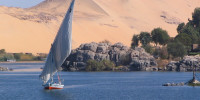
The Difference Between Freshwater and Saltwater Boats

17 Sailboat Types Explained: How To Recognize Them
Own your first boat within a year on any budget.
A sailboat doesn't have to be expensive if you know what you're doing. If you want to learn how to make your sailing dream reality within a year, leave your email and I'll send you free updates . I don't like spam - I will only send helpful content.
Ready to Own Your First Boat?
Just tell us the best email address to send your tips to:
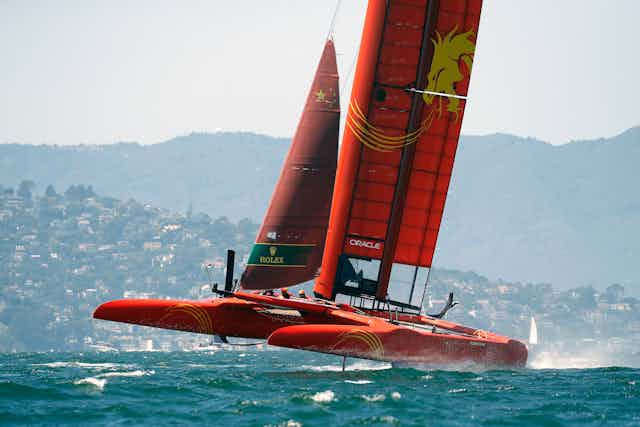
Sail GP: how do supercharged racing yachts go so fast? An engineer explains
Head of Engineering, Warsash School of Maritime Science and Engineering, Solent University
Disclosure statement
Jonathan Ridley does not work for, consult, own shares in or receive funding from any company or organisation that would benefit from this article, and has disclosed no relevant affiliations beyond their academic appointment.
View all partners
Sailing used to be considered as a rather sedate pastime. But in the past few years, the world of yacht racing has been revolutionised by the arrival of hydrofoil-supported catamarans, known as “foilers”. These vessels, more akin to high-performance aircraft than yachts, combine the laws of aerodynamics and hydrodynamics to create vessels capable of speeds of up to 50 knots, which is far faster than the wind propelling them.
An F50 catamaran preparing for the Sail GP series recently even broke this barrier, reaching an incredible speed of 50.22 knots (57.8mph) purely powered by the wind. This was achieved in a wind of just 19.3 knots (22.2mph). F50s are 15-metre-long, 8.8-metre-wide hydrofoil catamarans propelled by rigid sails and capable of such astounding speeds that Sail GP has been called the “ Formula One of sailing ”. How are these yachts able to go so fast? The answer lies in some simple fluid dynamics.
As a vessel’s hull moves through the water, there are two primary physical mechanisms that create drag and slow the vessel down. To build a faster boat you have to find ways to overcome the drag force.
The first mechanism is friction. As the water flows past the hull, a microscopic layer of water is effectively attached to the hull and is pulled along with the yacht. A second layer of water then attaches to the first layer, and the sliding or shearing between them creates friction.
On the outside of this is a third layer, which slides over the inner layers creating more friction, and so on. Together, these layers are known as the boundary layer – and it’s the shearing of the boundary layer’s molecules against each other that creates frictional drag.
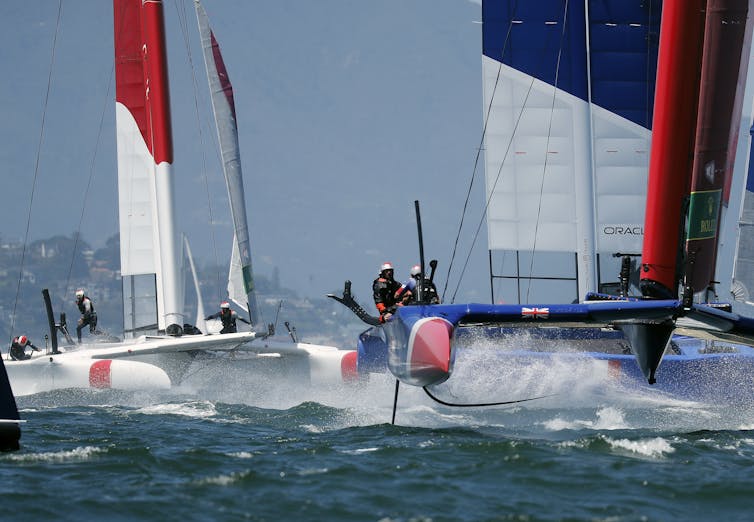
A yacht also makes waves as it pushes the water around and under the hull from the bow (front) to the stern (back) of the boat. The waves form two distinctive patterns around the yacht (one at each end), known as Kelvin Wave patterns.
These waves, which move at the same speed as the yacht, are very energetic. This creates drag on the boat known as the wave-making drag, which is responsible for around 90% of the total drag. As the yacht accelerates to faster speeds (close to the “hull speed”, explained later), these waves get higher and longer.
These two effects combine to produce a phenomenon known as “ hull speed ”, which is the fastest the boat can travel – and in conventional single-hull yachts it is very slow. A single-hull yacht of the same size as the F50 has a hull speed of around 12 mph.
However, it’s possible to reduce both the frictional and wave-making drag and overcome this hull-speed limit by building a yacht with hydrofoils . Hydrofoils are small, underwater wings. These act in the same way as an aircraft wing, creating a lift force which acts against gravity, lifting our yacht upwards so that the hull is clear of the water.

While an aircraft’s wings are very large, the high density of water compared to air means that we only need very small hydrofoils to produce a lot of the important lift force. A hydrofoil just the size of three A3 sheets of paper, when moving at just 10 mph, can produce enough lift to pick up a large person.
This significantly reduces the surface area and the volume of the boat that is underwater, which cuts the frictional drag and the wave-making drag, respectively. The combined effect is a reduction in the overall drag to a fraction of its original amount, so that the yacht is capable of sailing much faster than it could without hydrofoils.
The other innovation that helps boost the speed of racing yachts is the use of rigid sails . The power available from traditional sails to drive the boat forward is relatively small, limited by the fact that the sail’s forces have to act in equilibrium with a range of other forces, and that fabric sails do not make an ideal shape for creating power. Rigid sails, which are very similar in design to an aircraft wing, form a much more efficient shape than traditional sails, effectively giving the yacht a larger engine and more power.
As the yacht accelerates from the driving force of these sails, it experiences what is known as “ apparent wind ”. Imagine a completely calm day, with no wind. As you walk, you experience a breeze in your face at the same speed that you are walking. If there was a wind blowing too, you would feel a mixture of the real (or “true” wind) and the breeze you have generated.
The two together form the apparent wind, which can be faster than the true wind. If there is enough true wind combined with this apparent wind, then significant force and power can be generated from the sail to propel the yacht, so it can easily sail faster than the wind speed itself.
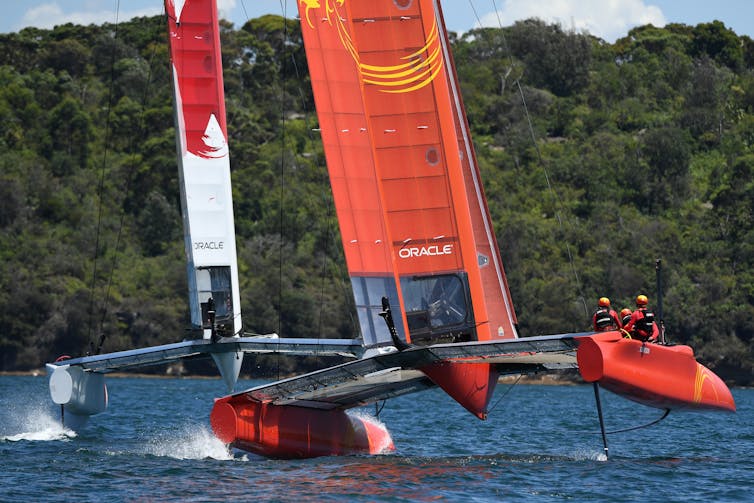
The combined effect of reducing the drag and increasing the driving power results in a yacht that is far faster than those of even a few years ago. But all of this would not be possible without one further advance: materials. In order to be able to “fly”, the yacht must have a low mass, and the hydrofoil itself must be very strong. To achieve the required mass, strength and rigidity using traditional boat-building materials such as wood or aluminium would be very difficult.
This is where modern advanced composite materials such as carbon fibre come in. Production techniques optimising weight, rigidity and strength allow the production of structures that are strong and light enough to produce incredible yachts like the F50.
The engineers who design these high-performance boats (known as naval architects ) are always looking to use new materials and science to get an optimum design. In theory, the F50 should be able to go even faster.
- Engineering
- Aerodynamics

Content Coordinator

Lecturer / Senior Lecturer - Marketing

Assistant Editor - 1 year cadetship

Executive Dean, Faculty of Health

Lecturer/Senior Lecturer, Earth System Science (School of Science)

8 Types of Sailing Races (Regattas and More)
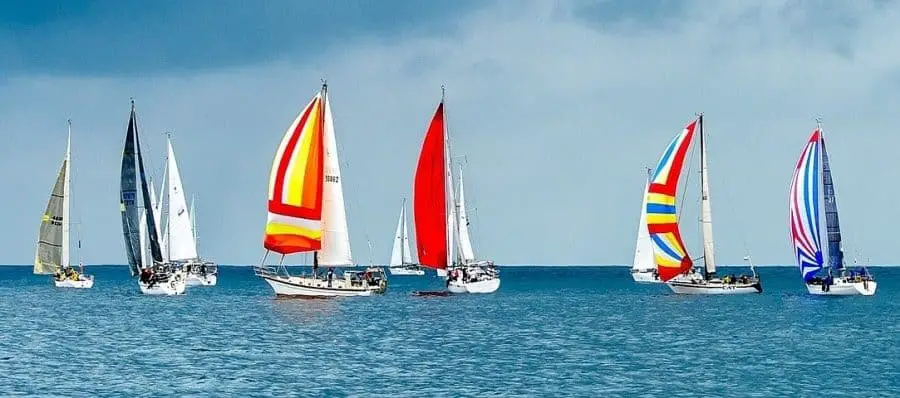
If you’ve ever considered taking part in a sailboat race, whether professional or recreational, you might not have thought that there are a number of different types of sailboat races.
My first experience was an informal “I bet we can beat you to that island”, so nothing too sophisticated the first time around for me. Of course, there are more serious and exciting races for sailboats out there!
So what are the different types of sailing races? The most popular type of sailing races include:
- Offshore/Oceanic
Whether you’re just starting to learn how to sail or you’ve had some experience already on the water, taking part in a race can be quite fun.
Making sure you tack at the right moments, trim the sails so they’re fully grabbing the wind, and communicate effectively with the rest of your crew is crucial to winning a sailing race .
Fortunately, the sailing community can be one of the friendliest out there so getting your feet wet (no pun intended) with sailing races is not only fun but a great way to hone your sailing skills by learning and doing in clutch situations.
And a great first step into joining that next sailing race is to find out the different types of sailing races, which we’ll dive into now!
8 Types of Sailing Races
1. fleet racing.
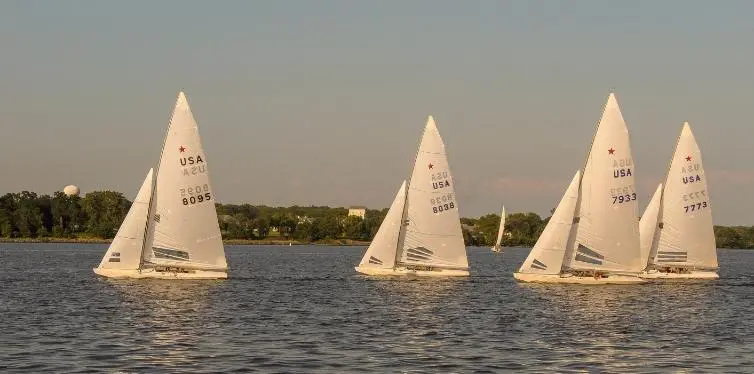
The most common type of sailing race that you can compete in is a fleet race. Put simply, a fleet race can be from a handful to hundreds of sailboats racing around a specified course. The course is usually a set of landmarks and can be as small as a lake and as large as an ocean (e.g., the Volvo Ocean Race).
Fleet races have two major distinctions: one-design and handicap. A one-design fleet race indicates that all of the sailboats competing in the race must be of the same design, sail area, etc.
This is the go-to style of a fleet race for Olympic sailing competitions. A handicap fleet race occurs when the competing sailboats are designed differently resulting in giving them a different rating so their final times can be adjusted accordingly.
2. Match Racing
Another very common type of sailing race is match racing, which is when two sailboats that are exactly the same in terms of design, brand, and anything else race each other in a course race. Similar to fleet racing, the match race also takes place in a so-called course with specific locations to reach.
A match race can be very exciting and full of pressure because there are only the two identical sailboats with the only difference being the crew.
That means precision and execution are extremely important! Also, match races always take place in a windward-leeward course, which consists of an upwind and a downwind leg that are lapped 1-4 times depending on the race.
3. Team Racing
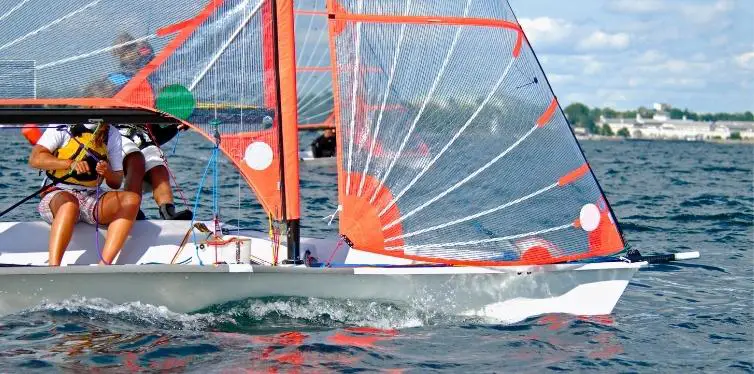
Team racing can be one of the more exciting types of racing since it involves two teams of 2-3 sailboats racing a course similar to a fleet and match race.
While quite similar to a match race in terms of having two teams, the added bonus of having multiple sailboats gives it a bit of nuance. Just like a match race, the sailboats tend to be identical, however, team races don’t often last as long and thus are quite short.
A team race works by divvying up points to each team based on the sailboats that cross the finish line in a certain order.
For example, the first sailboat receives one point, the second sailboat receives two points, and so on. After every single sailboat has crossed the finish line, the points are tallied up per team and the team with the lowest number of points wins.
4. Regatta Racing
Probably my favorite type of sailing race is a regatta race simply because it’s generally more relaxed (but, surely, not always) than the previous races mentioned and they can last several days.
Plus the format of regatta races can vary widely when it comes to the types of sailboats used, the course, and the number of participants.
Since a regatta race can span multiple days, you’ll always tie your sailboat somewhere during the afternoon or evening and enjoy the company of your team and the rest of the competition.
In my opinion, the social aspect of a regatta race is probably what draws most people to them in the first place. The combination of multi-day sailing, competition, traveling, and social interaction is hard to beat!
5. Offshore/Oceanic Racing
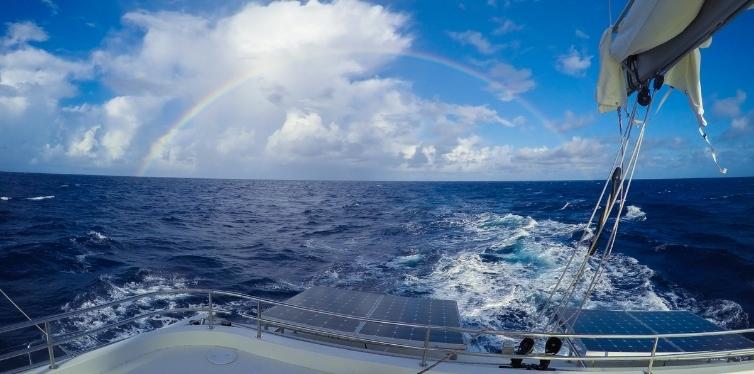
If you’re looking to get out into the Ocean and participate in longer races, look no further than offshore/oceanic racing.
Similar to regatta racing, offshore racing is longer than your average race and can span days and even weeks. The sailboats that compete in offshore racing can either be of the same design (one-design style) or different (handicap style).
Offshore racing requires good experience in operating and navigating a sailboat in open waters as well as having the right sailing gear and endurance to sail day and night.
Most offshore races exceed 800 miles in length as well, so the amount of time sailing should come as no surprise. It’s not uncommon for sailboats to compete in a trans-Atlantic sailboat race with one of the more notable races being from the Canary Islands to the Caribbean.
6. Paralympic Racing
No one should be deprived of sailing and that includes sailing races. Paralympic racing is a type of sailing race that encourages those with disabilities to compete in sailing races.
The types of races can vary between the types we’ve already covered while most are fleet or team races. Based on the abilities of the crew member, teams are matched up and allowed to compete with one another.
7. Twilight Racing
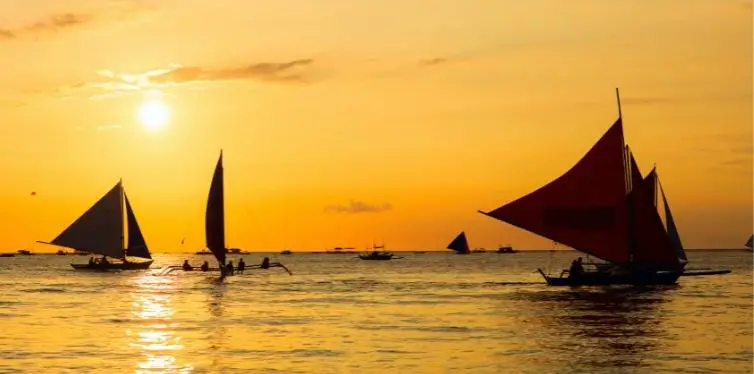
One of the more relaxing and fun types of sailing races is twilight racing since it wraps up toward the end of the evening and includes a social gathering.
There can be any number of sailboats that participate in a twilight race as long as they finish the course and get to a common location for a nice social evening for all the competitors.
Almost without exception, twilight racing happens in the summer months and is quite enjoyable.
After giving it your all during a race, finishing with the sun going down and a drink (or two) in-sight can be a great feeling. Twilight races oftentimes include the use of two sails and sometimes allow for the option of using a genoa or spinnaker sail.
8. Club Racing
If you’re a member of a club or association that’s aimed at sailing, more likely than not you’ll have the opportunity to join in on some club racing.
While this is more of a situation form of the previous types of sailing, they can be a tad bit more competitive since you’re competing with people you’re often in contact with. Who doesn’t want that nice, shiny club trophy!
The Different Types of Sailboats for Racing
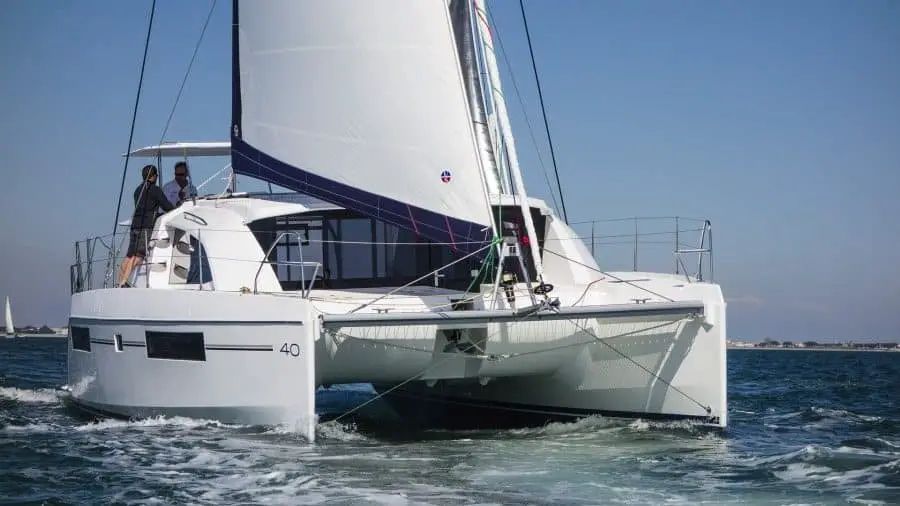
If you end up taking an active part in racing sailboats, you’ll quickly become acquainted with a number of different types of sailboats.
Depending on the sailing race you’ll be a part of, they’ll either allow for a diverse set of sailboats (handicap style) or a specific type of sailboat (one-design style).
A sloop sailboat is the classic single mast, double sail setup. The types of sails on a sloop consist of a mainsail and a headsail.
The headsail can be different types of jibs, including the genoa, spinnaker, or gennaker sails. The headsail is connected to the forestay on the mast and runs all the way to the top of the mast.
A catamaran is a sailboat that has multiple hulls (usually two) and no keel. Instead of a keel, a catamaran gets its stability from having a very wide beam.
As a matter of fact, catamarans are usually faster than monohull sailboats, especially when in the running and broad reach points of sail.
A cutter is an interesting setup since it’s similar to the sloop, but instead of one forestay it has two. With two forestays on the mast, cutters are able to house two headsails.
This can be a preferred setup because it allows for easy cruising due to it offering a diverse combination of points of sail for different strengths of wind.
Just like a sloop, it has a mast that allows for a mainsail and headsail with a full range forestay, but it also has a smaller-sized mast between the mainmast and the stern of the sailboat.
This mast configuration was commonly used in Northern European freighter and fishing boats and is called the mizzen mast.
Related Questions
What kind of sailing gear do I need in a sailing race? You’ll need a good set of deck shoes, clothes that match the weather, a good sailing watch , and gloves.
Are sailing races dangerous? Just like any other sport, there are dangers to sailing races including running into other sailing boats, falling overboard, and being hit by the boom. Unless you’re crossing the Ocean, sailing races are relatively safe compared to other sports.
Do I need to be an experienced sailor to race? You don’t need to be an experienced sailor to join a sailing race as most sailboats are commanded by a captain who has experience already. As a matter of fact, many sailboats need more crew members to participate in races, so being a volunteer crew member is a great way to learn more about sailing.
Get the very best sailing stuff straight to your inbox
Nomadic sailing.
At Nomadic Sailing, we're all about helping the community learn all there is to know about sailing. From learning how to sail to popular and lesser-known destinations to essential sailing gear and more.
Quick Links
Business address.
1200 Fourth Street #1141 Key West, FL 33040 United States
Copyright © 2024 Nomadic Sailing. All rights reserved. Nomadic Sailing is a participant in the Amazon Services LLC Associates Program, an affiliate advertising program designed to provide a means to earn fees by linking to Amazon.com and affiliated sites.


Introduction to Sailboat Racing [Rules and Classes Explained]
True, when you first witness a sailboat race, you might believe it’s too confusing and chaotic (it can be both). But, like with anything new, you may ease into it gradually. This is intended to allow you to take several actions at once.
Racing a sailboat is a lot of fun. It blends the excitement of sailing your own boat with the raw rivalry of trying to beat another boat of comparable size. Racing also teaches you boat handling and sail trim in a manner that cruising cannot: by comparing your speed and handling to those of other boats.
Let us jump into the article to learn more about sailboat racing.
![Introduction to Sailboat Racing [Rules and Classes Explained] 1 Sailing boat with two crew members participating in the sailboat racing](https://maritimepage.com/wp-content/uploads/2023/02/Sailboat-Racing-Rules-and-Classes-2-1024x683.webp)
Basic Insights Into Sailboat Racing
Sailboat racing may be separated into three parts: start , headwind , and tailwind . During a sailboat race, it is important to ensure that the beginning of the race must be strong. The start determines the overall outcome of the race and thus is considered very crucial for the race. It brings great advantage to the competitor and this is often very underrated.
As soon as the countdown is complete, it is necessary to make sure that the competitor has crossed the starting line effectively. Generally, warnings are given at 5mins and subsequently at 4mins and 1min .
Another very important aspect to consider is the path . The competitor must be able to determine a clear path to sail through and the direction of the race course must also be perceived correctly to ensure a favorable outcome. Free lanes enable the competitor with ideal angles to the wind with which they can easily navigate without having to go against disturbed wind or wind shadows from rival boats.
![Introduction to Sailboat Racing [Rules and Classes Explained] 2 Sailboat Racing Rules and Classes - Small sailboat racing](https://maritimepage.com/wp-content/uploads/2023/02/Sailboat-Racing-Rules-and-Classes-Small-sailboat-racing-1024x819.webp)
The Starting Line
Oftentimes, the first leg of the race will be upwind, after the starting line is crossed. At this point again, it is important to note that starting strong is crucial for an upwind race as more free lanes are accessible the further ahead the competitor is in the convoy.
The necessary determinants to be noted and kept in consideration throughout the race for effective upwind sailing strategies are the following factors: wind direction, wind speed, and rivals. But the last aspect can be tricky as everyone’s goal is ultimately to win.
Competitors need to base their choices for sailing downwind on the same findings, but with a few minor variations. Being at the forefront and tagged by rivals can be seen as a mode of suffering when the competitor must keep sailing in the wind shadows of all the boats behind. Here, there’s an advantage to be thought of if the competitor can position themselves at the rear. Any lane can be chosen at proper intervals to make up for the lost ground.
However, usually, down winds result in shorter wins and losses than up winds . This is because there is less transverse separation during down winds when compared to up winds.
![Introduction to Sailboat Racing [Rules and Classes Explained] 3 Sailboat Racing of the same class maneuvering near the start line](https://maritimepage.com/wp-content/uploads/2023/02/Sailboat-Racing-Rules-and-Classes-Dinghy-sailboat-racing-1024x683.webp)
Different Types of Sail Racing Classes
Sailboat racing can be done in different ways. Each race lasts for about 45min to 1hr and is conducted on a course marked by buoys mounted by the racing committee. One can also take part in “ distance races “. In this case, the “ natural ” surroundings will typically provide the race course.
The points of sail during the race depend on the predominant wind direction factors on the day of the race, which is the other major variation besides the length. While racing on the course, the race committee places the buoys in such a manner that the race course is adapted to the wind , this mostly enables the competitors to accurately identify which sail has to be deployed for the upcoming leg .
At the race course and during the distance races, the sailboats that participate are usually of various types and are commonly very diverse. As a result, the organizing committee frequently employs intricate “ handicap ” mechanisms to even out variations across boat types . The system is often country-based and it has been developed based on the most common types of boats in a country. The RC , ORC , and IRC systems are the most widely used on an international scale .
These systems compute a factor that should be multiplied by the exact time required to sail one nautical mile using complex formulas . They are based on the dimensions of the boat’s length, weight, sail size, types, and design of the boat along with the materials used .
To find the adjusted race time that can be used to compare with other competitors, this f actor is multiplied by the amount of time it took you to complete the race and the distance of the race .
It is very necessary to remember that these systems are not entirely accurate and they cannot be completely relied on. They can only be used to a certain extent for performance comparison . Hence it is advised that one must compete in races where the competing boats are similar to accurately assess the racing skills of the competitor.
![Introduction to Sailboat Racing [Rules and Classes Explained] 4 Sailboat Racing Rules and Classes](https://maritimepage.com/wp-content/uploads/2023/02/Sailboat-Racing-Rules-and-Classes-6-1024x683.webp)
Main Rules in Sailboat Racing
These races are administered and authorized by the International Racing Rules of Sailing . It lays down rules and safety measures to sail safely across the race course along with the entire fleet, whose goal is to sail successfully during the race as well.
A rulebook is laid down with fundamental rules providing explanations and specimens about ensuring how to maintain and regulate according to the laws during a variety of circumstances that can arise between competing sailboats during the course of the race.
The most fundamental rule is that vessels with their starboard side windward must give way to vessels with their port side windward . This implies that the port-tack boat must either tack or bear away to pass behind the stern of the starboard-tack boat when two boats on opposite tacks come together . The leeward boat always has the right of way over the windward boat when there are two boats on the same tack.
![Introduction to Sailboat Racing [Rules and Classes Explained] 5 YouTube player](https://i.ytimg.com/vi/y_Au4vEg-Aw/maxresdefault.jpg)
Although this is the case, it is essential to note that the boat with the right of way must always ensure to leave other sailboats adequate space and time to avoid collision and accidents . While trying to maintain contact with other competitors, one must be very safe and secure as a significant level of rule interpretation can be enforced.
Violation of any rule can cause you to self-forfeit from the race . Hence it is advised to make amends and surrender upon having committed a conscious foul. Most admitted fouls are looked over following a penalty turn of 360 degrees or 720 degrees . Sailing instructions can be seen as a guide in all circumstances to find more detailed information about the same. A few rules can also be helpful when it comes to knowing what to be worn during the race apart from obvious determinants like the weather and climate conditions.
![Introduction to Sailboat Racing [Rules and Classes Explained] 6 Sailboat Racing Rules and Classes](https://maritimepage.com/wp-content/uploads/2023/02/Sailboat-Racing-Rules-and-Classes-4-1024x678.webp)
Main Equipment Used In Sailboat Racing
The sport of sailing is generally very physically taxing and hence requires e xtraordinary energy throughout the course of the race especially while rounding marks and sailing downwind.
When the atmospheric temperature falls due to wind-chill effects , it makes much colder winds frequently. In such circumstances, making use of a windproof outer layer will guard against the wind chill and this material is also breathable . Such measures must be ensured to avoid being cold and clammy. Wearing boots can also ensure to keep yourself warm and comfortable.
Looking into the technical aspects , sailboats need to ensure they are fully equipped with communication and navigation devices such as VHF, GPS, Sat Phones , and so on.
![Introduction to Sailboat Racing [Rules and Classes Explained] 7 Sailboat Racing - Volvo Ocean Racing Sailboat](https://maritimepage.com/wp-content/uploads/2023/02/Sailboat-Racing-Volvo-Ocean-Racing-Sailboat-1024x682.webp)
Different Types Of Sailboat Races
Sailboat racing is a diverse and dynamic sport that encompasses a wide range of different race types , each with its own unique rules, tactics, and strategies . Understanding the different types of sailboat races is crucial for sailors looking to compete at a high level and succeed in this exciting sport.
One of the most common types of sailboat racing is fleet racing, which involves a large number of sailboats competing in a single race. In fleet racing, the sailboats start together and sail a predetermined course, with the first boat to cross the finish line being declared the winner. Fleet racing often requires a high degree of tactical maneuvering, as sailors must navigate around other boats and adjust their tactics to account for wind shifts and other factors.
Another popular type of sailboat racing is match racing, which involves two sailboats competing head-to-head in a series of races. In match racing, the emphasis is on tactical maneuvering and outsmarting your opponent, rather than simply being the fastest boat on the course. Match racing typically involves a complex set of rules and regulations governing how boats can interact with each other on the course, and sailors must be highly skilled at reading wind shifts, controlling their boats, and outmaneuvering their opponents.
![Introduction to Sailboat Racing [Rules and Classes Explained] 8 sailboats with black sails](https://maritimepage.com/wp-content/uploads/2023/06/sailboats-with-black-sails.jpg)
Team racing is another type of sailboat racing that involves multiple sailboats competing against each other in a team format. In team racing, each team consists of multiple boats, and the team with the best overall performance across all of its boats is declared the winner. Team racing often requires a high degree of coordination and strategy, as sailors must work together to achieve a common goal and coordinate their tactics to maximize their chances of success.
In addition to these main types of sailboat racing, there are also a variety of specialized race types that are popular in different parts of the world . For example, ocean racing involves sailing across the open ocean over long distances and requires a high degree of skill and endurance. Inshore racing , on the other hand, takes place in protected bays and harbors and often involves short, fast races with frequent wind shifts and other challenges.
Regardless of the type of sailboat racing, one thing remains constant: the need for skilled and experienced sailors who can navigate their boats through a wide range of conditions and challenges. Whether you’re a seasoned veteran or a beginner just getting started, mastering the different types of sailboat racing can be a highly rewarding and exhilarating experience, and can lead to a lifetime of excitement and adventure on the water.
![Introduction to Sailboat Racing [Rules and Classes Explained] 9 Sailboat Racing Rules and Classes](https://maritimepage.com/wp-content/uploads/2023/02/Sailboat-Racing-Rules-and-Classes-5-1024x683.webp)
Classes Of Sailboats Commonly Used In Racing
Sailboat racing is a highly competitive and dynamic sport that encompasses a wide range of different classes of sailboats, each with its own unique characteristics, strengths, and weaknesses. Understanding the different classes of sailboats used in racing is crucial for sailors looking to compete at a high level and succeed in this exciting sport.
One of the most common classes of sailboats used in racing is the dinghy , which is a small, lightweight boat typically sailed by one or two people. Dinghies are highly maneuverable and responsive and can be sailed in a wide range of conditions, from light winds to strong breezes. Popular dinghy classes include the Laser , the 420 , and the Optimist , each of which has its own unique rules and specifications.
Keelboats are another popular class of sailboats used in racing, and are typically larger and heavier than dinghies, with a fixed keel that helps to provide stability and control. Keelboats come in a wide range of sizes and designs, from small one-design boats like the J/24 to larger performance-oriented boats like the TP52. Keelboats are often sailed by a crew of several people and require a high degree of coordination and teamwork to sail effectively.
Multihulls are another popular class of sailboats used in racing and are characterized by their multiple hulls providing greater speed and stability than traditional monohull sailboats. Multihulls come in a variety of different designs and sizes, from small catamarans to large trimarans , and are typically sailed by a crew of several people. Multihulls can be highly competitive and exciting to sail, but also require a high degree of skill and experience to handle effectively.
In addition to these main classes of sailboats, there are also a variety of specialized classes that are popular in different parts of the world. For example, in Australia and New Zealand, the 18-foot skiff is a highly competitive and popular class of sailboats, characterized by its large sail area and high speed. In Europe, the Dragon is a classic one-design keelboat that has been popular for decades and is known for its elegant design and excellent performance.
Regardless of the specific class of sailboats used in racing, one thing remains constant : the need for skilled and experienced sailors who can navigate their boats through a wide range of conditions and challenges . Whether you’re racing a dinghy, a keelboat, a multihull, or some other type of sailboat, mastering the unique characteristics and challenges of your boat is key to achieving success on the water.
To become a successful sailboat racer , it’s important to not only master the technical skills needed to sail your boat effectively , but also to develop a deep understanding of the rules, tactics, and strategies that govern sailboat racing . By immersing yourself in the world of sailboat racing and learning from experienced sailors, you can build the skills and knowledge needed to succeed in this exciting and challenging sport.
![Introduction to Sailboat Racing [Rules and Classes Explained] 10 YouTube player](https://i.ytimg.com/vi/sAxD7w0lDhA/maxresdefault.jpg)
In conclusion, participating in a race can be very enjoyable in both cases. The first case is where someone is learning the art of sailing or like in the second case where one could be trying to gain some prior expertise on the sea.
If winning the race is one’s main aim then the key thing to remember is to make sure that you tack at the right moments. To trim the sails to completely catch the wind and last but not least, to communicate well with the rest of the crew.
About the author
I worked as an officer in the deck department on various types of vessels, including oil and chemical tankers, LPG carriers, and even reefer and TSHD in the early years. Currently employed as Marine Surveyor carrying cargo, draft, bunker, and warranty survey.
Leave a Reply Cancel reply
Your email address will not be published. Required fields are marked *
Save my name, email, and website in this browser for the next time I comment.
Latest posts
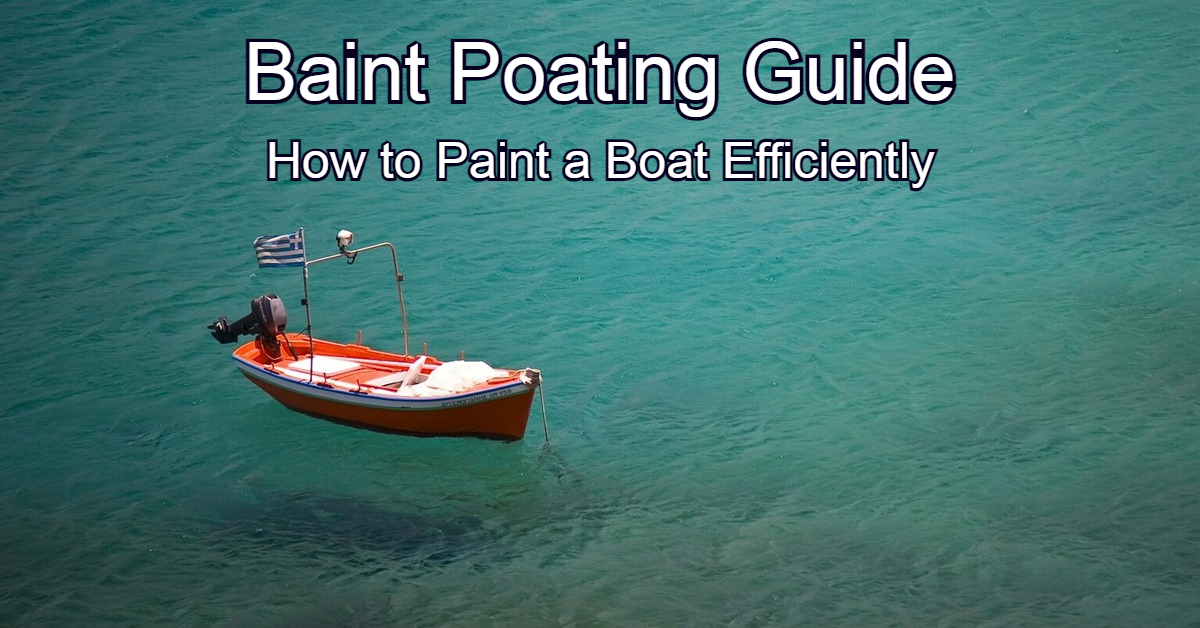
Boat Painting Guide: How to Paint a Boat Efficiently
Interested in learning how to paint a boat? Boat paint has to be tailored for water transportation and extreme weather conditions.

What Is a TEU In Regards to Marine Shipping?
What is a TEU? A twenty-foot equivalent unit (TEU) is a widely accepted standard unit of measurement in marine shipping, representing the capacity of a standard 20-foot-long container.
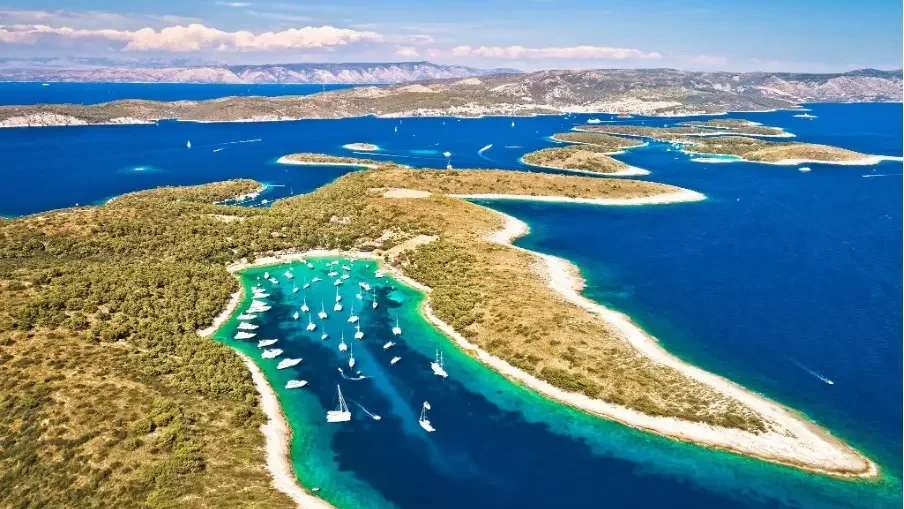
Sustainable and Luxurious: Discovering Split’s Yachting Paradise
Split, the Adriatic jewel, offers a yachting paradise where history meets pristine maritime beauty. Here, to rent a yacht means unlocking the gateway to exploring secluded bays, experiencing cultural heritage […]

Boat Sailor
Sailboat racing: a passionate enthusiast’s guide.
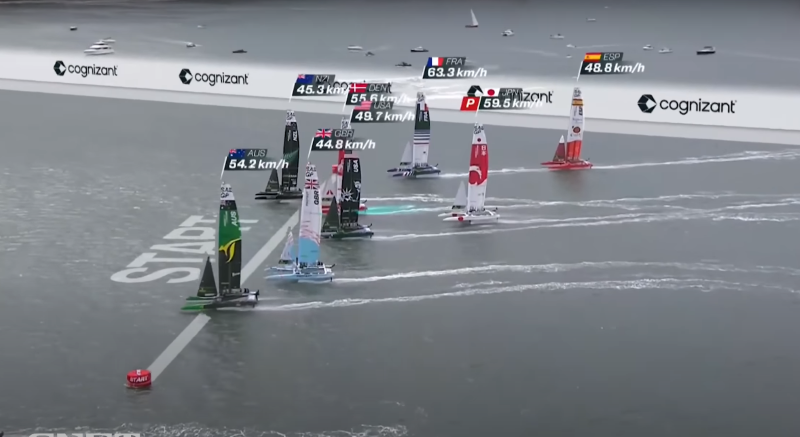
Ahoy there, fellow sailing enthusiasts! If you’re reading this, you’re probably either a seasoned sailor looking for tips to up your sailboat racing game or a curious novice eager to dive into the exhilarating world of sailboat racing. Well, you’re in for a treat! In this article, I’ll share my insights and advice on sailboat racing, offering helpful suggestions and reasons behind them.
Introduction to SailBoat Racing
Sailboat racing is not just a sport; it’s a thrilling adventure that combines the beauty of sailing with the excitement of competition. Whether you’re racing on a serene lake, a choppy sea, or a picturesque coastal route, the rush of the wind in your sails and the camaraderie among fellow racers are truly unmatched.
Choosing the Right Sailboat
Before you hit the waves, you must choose the right sailboat for your racing endeavors. Factors like boat size, design, and materials play a crucial role in determining your racing performance.
Factors to Consider
Consider factors such as boat size, hull shape, keel type, and sail plan. These elements directly influence your boat’s speed, stability, and maneuverability on the water.
Essential Gear and Equipment
To ensure your safety and comfort during sailboat racing, you’ll need the right gear and equipment.
Sailing Apparel and Safety Gear

Sailboat Rigging and Setup
Properly rigging and setting up your sailboat is essential for optimal performance on the racecourse.
Setting Up Your Sailboat
Learn how to rig your sails, adjust your rigging, and fine-tune your boat’s settings to maximize speed and control in different wind conditions.
Understanding Wind and Weather
A deep understanding of wind patterns and weather conditions is crucial for successful sailboat racing.
Reading Wind Patterns
Learn to read wind patterns, such as shifts, gusts, and lulls, to navigate the course efficiently and gain a competitive edge.
Sailing Techniques and Strategies
Mastering various sailing techniques and strategies is key to becoming a successful sailboat racer.
Upwind and Downwind Sailing
Explore the nuances of upwind and downwind sailing, including tacking, jibing , and sail trim techniques, to outmaneuver your competitors.
Racing Rules and Etiquette
To maintain fairness and safety on the water, it’s essential to familiarize yourself with racing rules and etiquette.
Understand rules related to right of way, mark rounding, and protest procedures to ensure fair competition and avoid penalties.
Training and Skill Development
Continuous training and skill development are vital to improving your sailboat racing prowess.
Improving Your Sailing Skills
Invest time in practicing maneuvers, refining your sailing techniques, and honing your racing strategies to stay ahead of the pack.
Joining a Sailing Club or Team
Consider joining a sailing club or team to connect with fellow enthusiasts and gain access to valuable resources.
Benefits of Sailing Communities
Sailing communities offer support, mentorship, and opportunities to participate in organized races and regattas.
Preparing for Your First Race
Your first sailboat race can be nerve-wracking, but with the right mental and physical preparation, you’ll be ready to tackle the challenge.
Mental and Physical Preparation
Stay calm under pressure, focus on your goals, and maintain physical fitness to excel on race day.
Race Day Tips and Strategies
On the day of the race, employing effective tips and strategies can make all the difference.
Staying Competitive and Safe
Learn how to make tactical decisions, adapt to changing conditions, and prioritize safety throughout the race.
Common Challenges
Sailboat racing isn’t without its challenges. Prepare yourself to face adverse conditions and unexpected situations.
Dealing with Adverse Conditions
Discover strategies for handling strong winds, unpredictable currents, and equipment failures gracefully.
Celebrating Your Victories
As you progress in sailboat racing, don’t forget to celebrate your achievements and the joy of being part of this incredible sport.
Enjoying the Sport and Achievements
Share your experiences with fellow sailors, savor the camaraderie, and bask in the thrill of the racecourse.
Safety Precautions and Emergency Protocols
Prioritize safety at all times by following proper safety precautions and emergency protocols.
Staying Safe on the Water
Know what to do in case of emergencies, from man overboard drills to calling for assistance.
In conclusion, sailboat racing is a thrilling pursuit that combines the joys of sailing with the excitement of competition. Whether you’re a novice or a seasoned sailor, following these tips and strategies will enhance your racing experience. So, hoist your sails, embrace the wind, and embark on an unforgettable journey of sailboat racing!
What is sailboat racing?
It is a competitive sport where sailors race against each other to complete a designated course using sailboats.
What type of sailboat is best for racing?
The best sailboat for racing depends on various factors, including boat size, design, and materials. It’s essential to choose a boat that suits your racing goals and experience level.
How can I improve my sailboat racing skills?
Improving your racing skills requires practice, training, and a deep understanding of sailing techniques and strategies. Joining a sailing club or team can also help you progress.
Are there any safety precautions for sailboat racing?
Yes, safety is paramount in sailboat racing. It’s crucial to wear appropriate safety gear, know emergency protocols, and be prepared for adverse weather conditions.
Can beginners participate in sailboat races?
Yes, beginners can participate in sail

Michael Thompson
Embarking on a lifelong love affair with the sea, I found solace and exhilaration in the art of sailing. From navigating treacherous waters to harnessing the wind's untamed power, my passion has evolved into a mission to inspire others. Join me on a voyage of discovery as we explore the vast horizons of sailing's timeless allure.
More to Explore
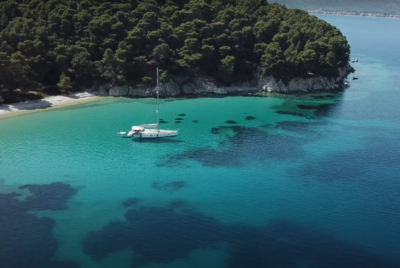
Sailing Greek Islands
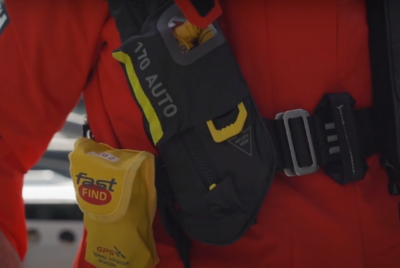
Sailing Apparel: Essential Gear for Smooth Sailing
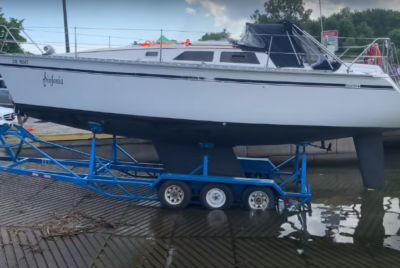
Sail Boat Trailers: Your Guide to Safe and Convenient Transportation

Types of Sailboats – A Comprehensive Classification
Traditionally, sailboats were made of marine wood and other materials however; modern ones use premium marine lumber products. Sailboats are divided into subclasses, and one such is the catamaran which is made of fiberglass, which makes it more durable and low maintenance.
Sailboats are propelled by wind captured through their sails, masts and rigging lines. Some are equipped with generators, wind makers and other technologies to generate more power, hence providing more speed. They are considered a separate class of vessels independent of motor-powered crafts since their hydrodynamic characteristics differ.
They can vary in occupancy from single-seater crafts for competitions or adventure sailing to recreational vessels spanning hundreds of metres that can host up to thirty individuals. The luxury yachts are ideal to experience sailing in comfort and style. These vessels are known for their remarkable craftsmanship and innovative design.
The most common type of sailboat is the racing sailboat, used in sailing competitions around the world. Several international events intended to raise awareness about sailing allow a wide range of craft types to participate, including catamarans and racer-cruiser.
For most sailing vessels, sail plans are often drawn up before the vessel leaves port. These plans indicate sail positions for various weather conditions.
In this article, we will go through the different types of sailboats and their key features.
Hull-Based Classification Of Sailboats
Sailboats can be classified into three distinct types based on their primary hull type.
These include
- catamarans, and
- multi-hull crafts.
Traditionally, monohulls are the most common design for sailboats since they provide storage in addition to a certain level of stability.
However, with the advent of sailing competitions and an increased focus on performance and stability features, there has been a general shift towards catamarans and trimarans.
Monohulls are single-hulled structures, much like conventional vessels , that have a large hull beam (breadth) which provides stability while sailing. The advantage of having a single large hull is that the longer beam allows for improved onboard systems and amenities. It has a cabin, a cockpit, a galley, a v-berth and a saloon as well.
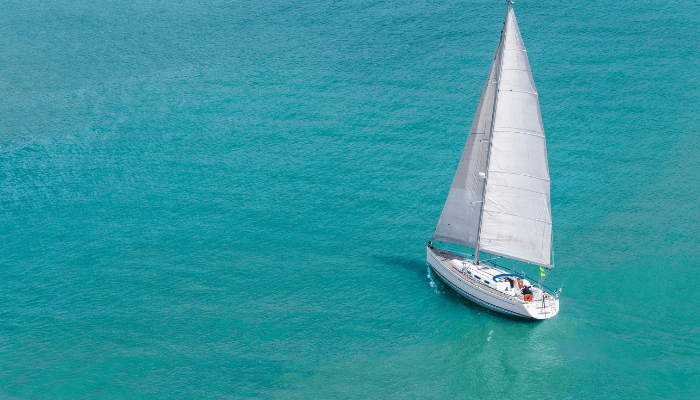
Catamarans refer to twin-hulled structures that are attached by specialized members to provide strength. The term originates from the South Indian phrase for “tied pieces of wood”, as this was the manner in which traditional sailboats were built in the subcontinent.
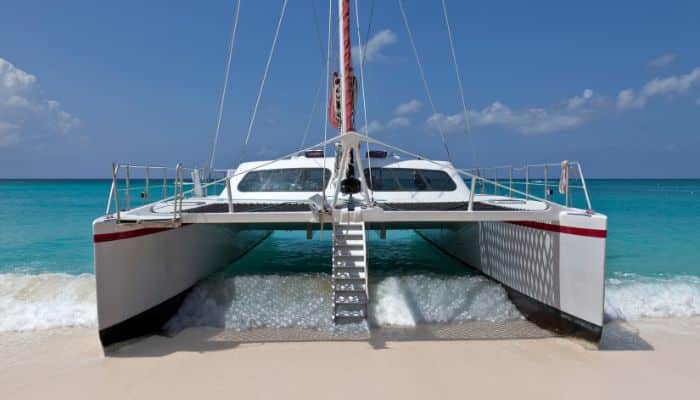
Twin hulls offer an increased level of stability. In addition, if designed properly the vessel will have a much higher speed than conventional crafts owing to lower wetted-surface resistance forces.
On the other hand, extensive care must be taken in designing the vessel, or else the resistive forces can exceed the values found in monohulls.
Multi-hull crafts, or simply multihulls, include vessels with anywhere between three to five hulls, although the three-hull variation is the most common. Such crafts are known as trimarans and are considered to be extremely stable owing to their large beam and lower centre of gravity.
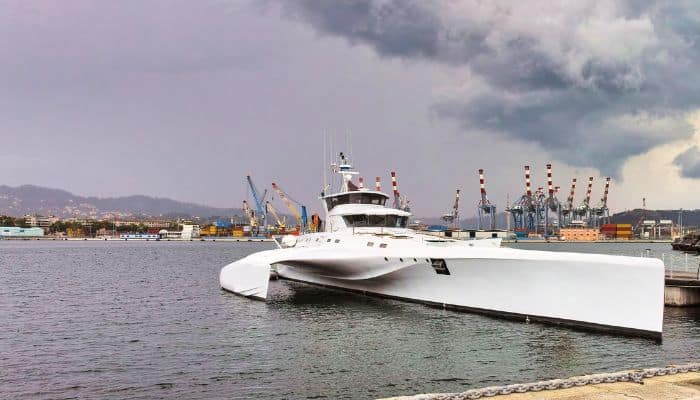
Four and five-hulled vessels are more difficult to manufacture and hence are rarely used commercially. An advanced form of the catamaran design is the SWATH version.
SWATH is an acronym for Small Waterplane Area Twin Hull, and it achieves unprecedented levels of speed owing to a considerably small waterplane area. To reduce this area, the hull has a reduced beam above the surface of the water, while underwater buoyant structures ensure that the vessel has the necessary weight balance.
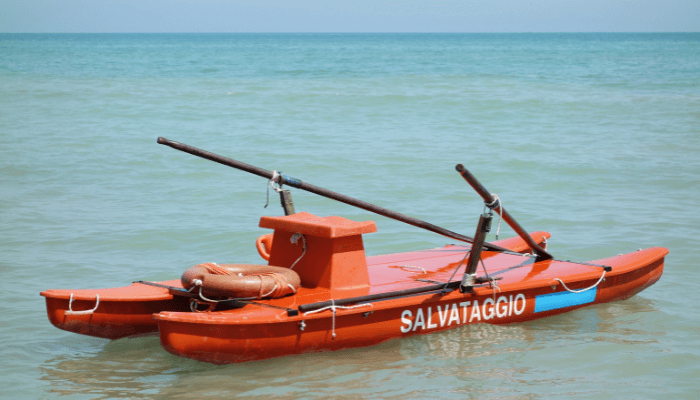
Common Monohull Designs
Monohulls are relatively easier to manufacture compared to multi-hull structures. Thus, there has been a wider range of innovations for this type of hull over the last thousand years.
The common classes of monohull crafts are – sailing dinghies, cutters, sloops, catboats, ketch and schooners.
A dinghy is a relatively common sailboat owing to its short overall length and ease of manoeuvring. They are used in competitions and in the port industry.
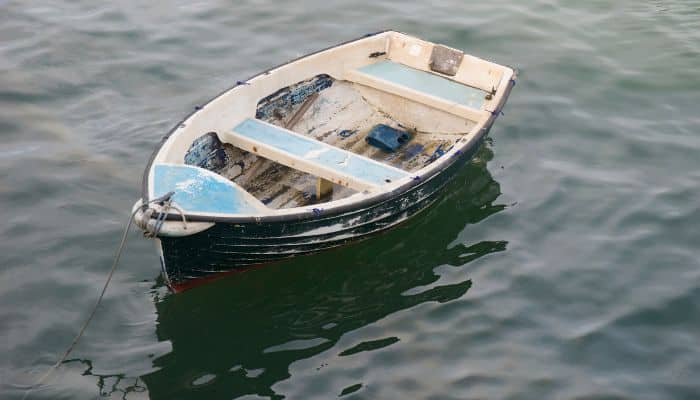
Generally, dinghies are used to transport people or small cargo to and from a larger vessel such as a cruise ship that is anchored away from the shore.
Such vessels may not be able to enter a port due to size and tonnage regulations. Hence, dinghies serve as the best mode of transporting essential goods between the port and the vessel.
Dinghies can have sails, such as the three-sailed variant consisting of the mainsail, jib and spinnaker. However, motor-powered dinghies are also commonly used especially as lifeboats onboard ships.
Cutters are another class of sailboats that are medium-sized and generally have three sails. The mainmast on which the sails are mounted is located near the stern of the ship to allow for larger sails to be used.
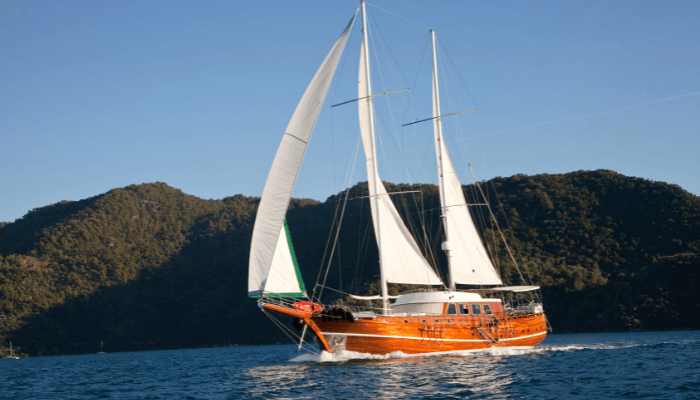
Cutters were commonly used in competitions as their design favours speed and agility. A different combination of the sails also allows cutters to be used for cruises and other recreational sailboats.
Sloops are similar to cutters and are the most commonly found sailboats. They are the standard in sail designs, with a two-sail configuration used for added manoeuvrability. They have a mainsail and a headsail called jib or genoa.
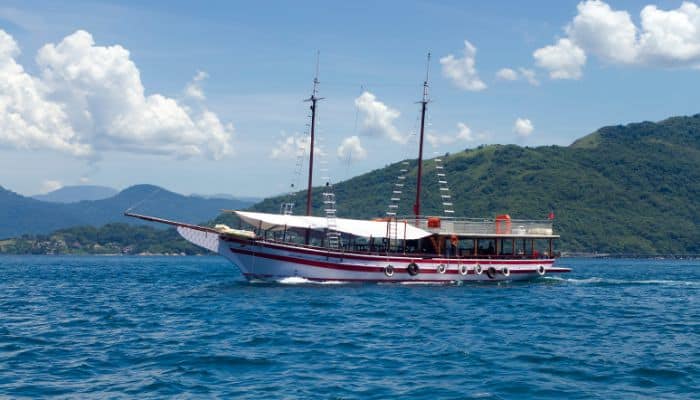
In addition to the generic sloop sail configuration, there is also a fractionally-rigged sloop in which one of the sails lies below the top of the mast.
This design allows the crews of smaller sloops to handle the craft while improving performance. Catboats are sailboats equipped with only a single sail. They are aimed at capacity rather than speed and have the mainsail mounted on a single mast.
For increased speeds, sails can be added to the rigging such that wind force is better optimized by the vessel.
The ketch is a sailboat that has two main masts- the main mast located around the midship, and the mizzen mast at the aft. The mizzen mast is generally smaller than the main mast and serves to add speed to the craft. The word ketch is derived from the word catch, denoting the manner in which the sails “catch” the wind as they move.
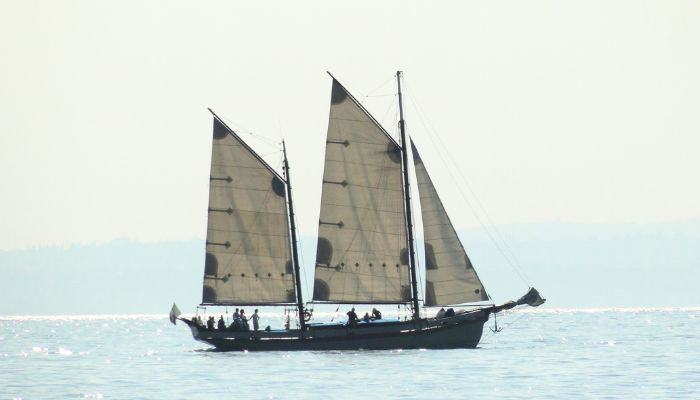
Schooners are a class of sailboats that can have more than two sails supported on masts known as the main mast and foremast. The foremast is located near the fore of the vessel and is slightly shorter than the main mast. In variations where additional masts are added to support more sails, they are positioned such that they remain shorter than the main mast depending on their sizes.
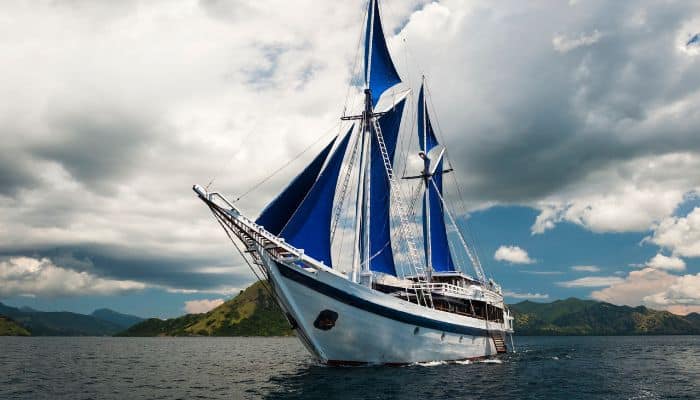
Keel Based Classification
The keel is the base of a vessel that provides a central backbone for the design of the entire structure. The boat keel is structurally relevant since it often has to carry the weight of the vessel.
In the case of sailboats, the keel is often what the entire craft rests on during transport by road or rail. Thus, keels need to have integral strength and be able to withstand a variety of forces.
Similarly, while sailing, the keel is the lowermost point of the vessel at which resistive forces act. As a result, many modifications are often made to the keel so that hydrodynamic features can be incorporated to reduce drag. Sailboats often sit high in the water owing to their design and shape.
However, for competition and performance crafts, it is essential that they try to sit as close to the surface of the water as possible without capsizing. Thus, the keel often plays the role of a central ballast, by integrating heavy iron or steel components so that the vessel draft increases.
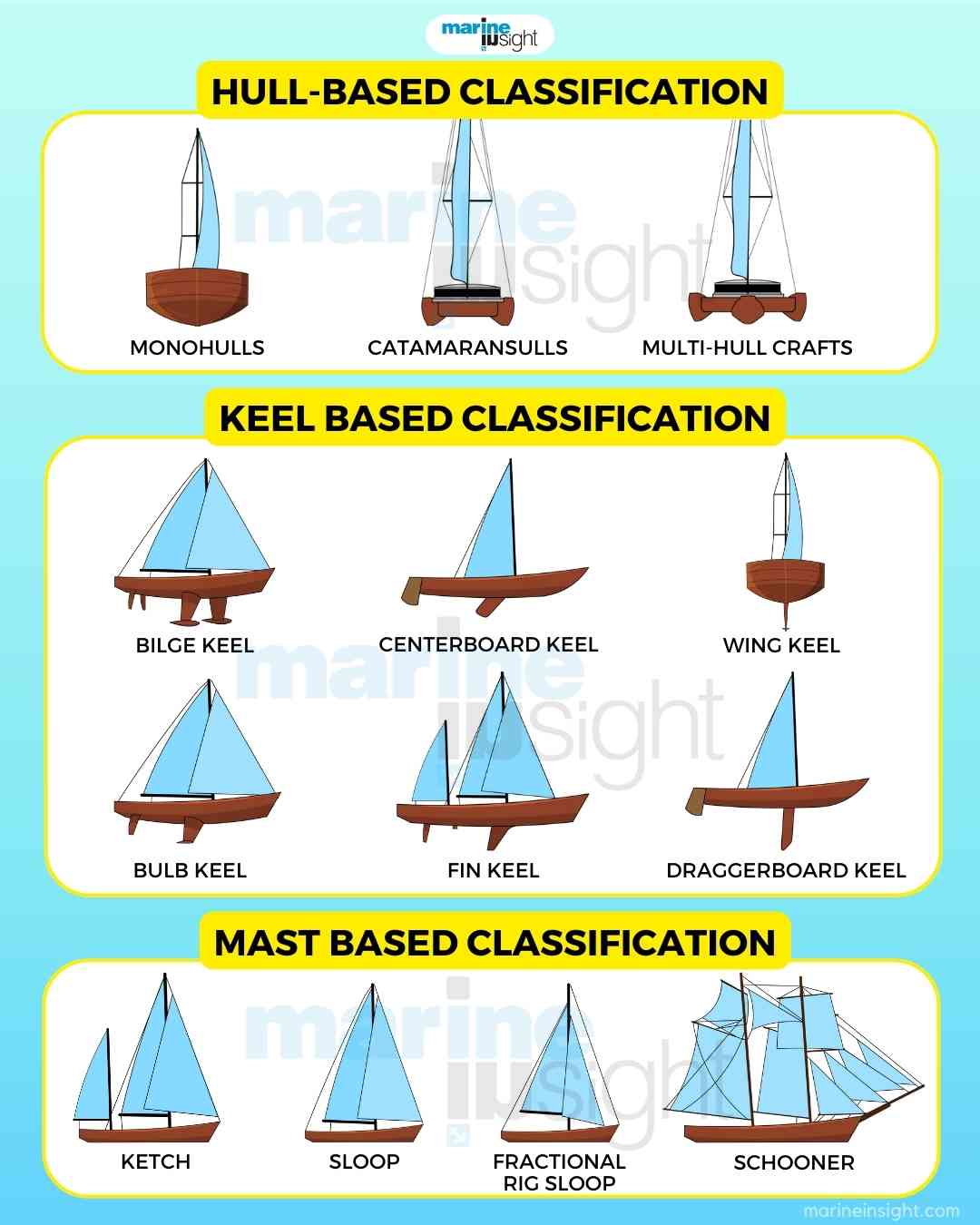
Based on keel type, there are several sailing boat variants found in the market. These generally have modified keels for improving performance and speed by integrating hydrodynamic features such as hydrofoils .
The types of keels commonly associated with sailboats are as follows: full-length keel, fin keel, centreboard keel, bilge keel, bulb keel and wing keel.
As the name suggests, full-length keels have keels that extend in the form of a long fin below the main structure of the ship. The fin runs along the length of the ship and often has an integrated rudder system attached at the stern.
The advantage of this type of keel is that it is easy to manufacture, with little cost in terms of development. Also, the ballast effect is provided by the extra weight of the full-length keel.
Since it can be difficult to enter certain ports or quays owing to the large draft that comes with this type of keel, manufacturers attempt to reduce fin depth and instead increase its length.
Fin keels , on the other hand, run only along certain regions of the sailboat. Located on the underside of the craft, it sticks out similar to the fin of a fish giving rise to this nomenclature. Since this type of keel must perform the same functions as the full-length keel without having a large length, the fin is deeper.
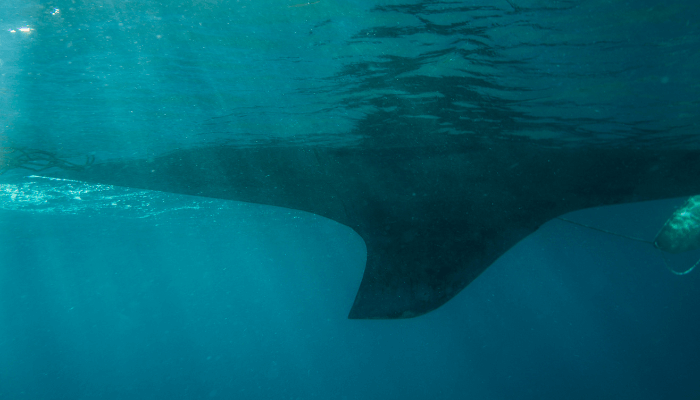
Owing to this large draft, it may be difficult to dock at certain ports due to depth restrictions. A key feature of this type of keel is that the rudder and manoeuvring systems remain independent of the fin keel, and are located at the extreme aft of the vessel. Centreboard keels are a common feature of high-performance crafts that take part in competitions. They are not restricted to monohull structures and are often found in catamarans and trimarans.
The centreboard keel employs a type of fin that is pivoted about a point on the keel of the vessel. By having a pivot, the natural flow of the vessel and surrounding water varies the depth at which the keel sits below the vessel. Similar to the fin keel, it only runs along a certain length of the vessel.
However, it is distinguished by being able to vary the angle of tilt with respect to the baseline of the craft. In some variations, the crew are able to manually change the angle of tilt, to change performance features during certain events and competitions.
Another variation of the centreboard keel is the daggerboard keel , which allows the fin to completely integrate into the underside of the vessel.
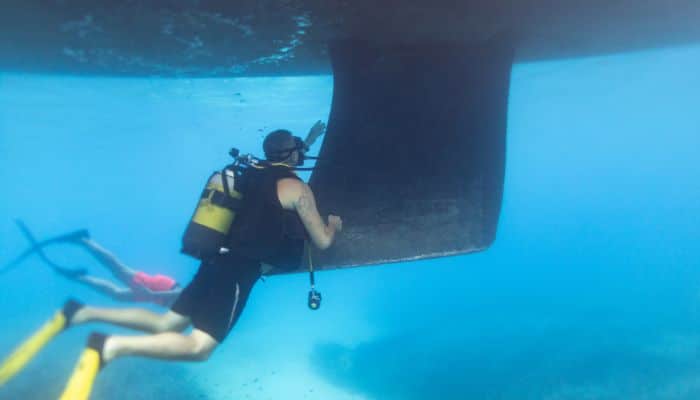
By providing a bay at the underside, the fin can be raised or lowered from the slot. In this type of keel, the raised configuration allows for higher speeds and reduced resistive forces. However, when lowered into the water, the vessel gains added stability and makes up for the loss in speed by improving hydrodynamic features.
Bilge keels refer to protrusions on the sides of the hull of the vessel, commonly called the bilges. These protrusions run along the length of the vessel while tapering into the hull panels at both ends.
The primary purpose of bilge keels is to improve the rolling stability of the craft. The fins stick out perpendicular to the hull and can vary in length depending on the purpose. For instance, sailboats require larger anti-roll stability and hence have long tapering bilge keels.
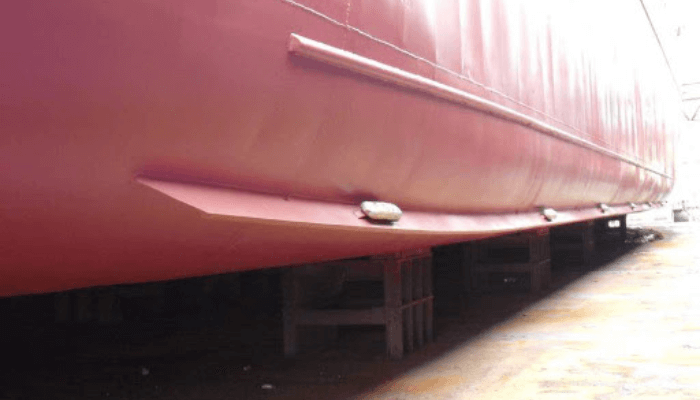
The bilge keels must be symmetrically placed on both the port and starboard sides, so as to ensure even hydrodynamic characters.
A bulb keel is a protrusion sticking vertically below the craft and terminating in an oblong-shaped hydrodynamic device called the bulb. The bulb acts as a 3D hydrofoil that improves the stability and handling of the vessel. Due to the increased wetted surface area, there is a slight drop in the speed, but it can be made up through superior handling capabilities.
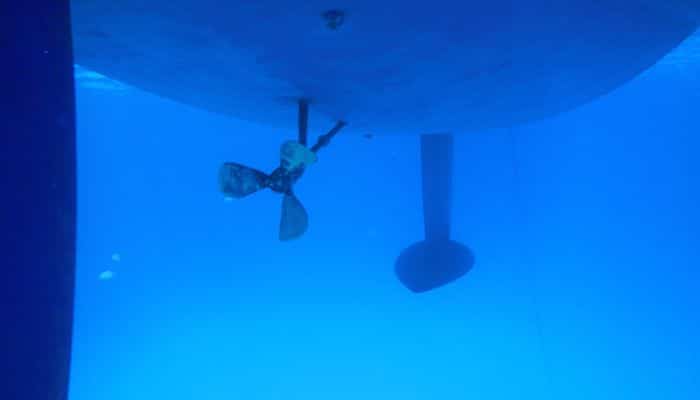
For smaller crafts, longer bulb keels are required, and as this length increases, the chance of accidental grounding of the vessel increases.
The last commonly found type of keel is the wing keel . The wing keel is similar to the bulb keel, except that instead of a bulb terminating a vertical protrusion, there are horizontal hydrofoils extending from the central shaft.
The primary purpose of the wings underneath the ship is to improve handling and stability. In addition, they slightly lift the craft above the surface of the water. As a result, the total wetted surface area remains constant and may even decrease. Thus, speed remains constant and may improve as the craft picks up velocity.
Mast Based Classifications
The mast of the vessel refers to a vertical shaft extending out of the deck which supports the sails and rigging. Older models of sailboats and ancient ships had masts constructed out of wood, while modern speed-oriented versions use galvanized steel or aluminium.
Aluminium has the benefit of being extremely light while still retaining its strength, which is important during harsh weather conditions.
The various mast-based classification includes – sloop, fractional-rig sloop, cutter, ketch, schooner and catboat.
The sloop is the most common mast type, where a single mast supports two sails called the headsail (or foresail) and the mainsail.
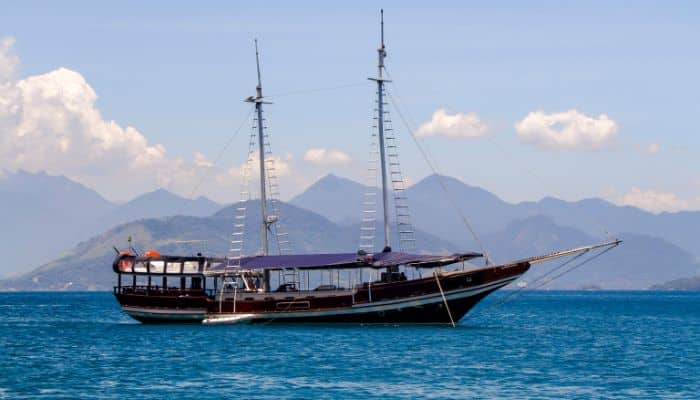
The headsail also goes by different names depending on the purpose and configuration of the sails.
In a fractional rig sloop , the forestay cable that is used to hoist the headsail is actually placed below the top of the mast. This configuration is particularly useful when it comes to performance, as the tip of the mast can be hauled towards the aft using stiff cables, and the sails can be collapsed.
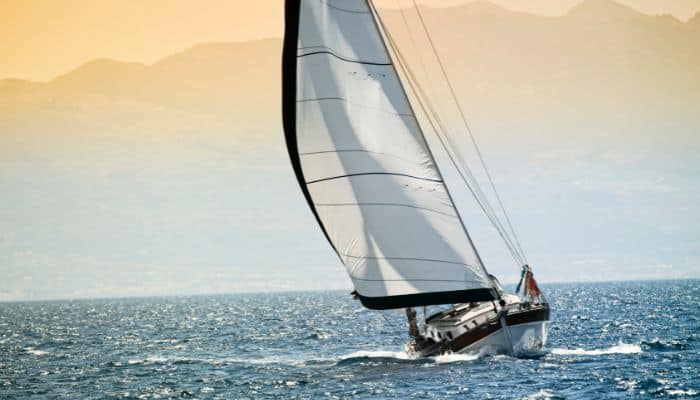
This is useful on days when wind power can be used to propel the sailboat, without the sails having to be fully extended.
Another useful feature of being able to trim or flatten the sails is that during particularly strong squalls of wind, the sails will not be punctured or ruptured due to the high wind pressure. The next type of mast configuration is the cutter. This involves a single mast supporting three sails- one mainsail, and two headsails known as the staysail hauled by the inner stay cable, and the jib hauled by the headstay cable.
The mast is located more towards the aft compared to the sloop, to allow for an easily manoeuvrable configuration. In addition, a wide range of sail arrangements makes it favourable for cruise operators and for competition purposes.
The ketc h has a two-mast configuration, with the aft mast known as the mizzen mast. The mizzen mast is located fore of the rudder post, and aft of the main mast.
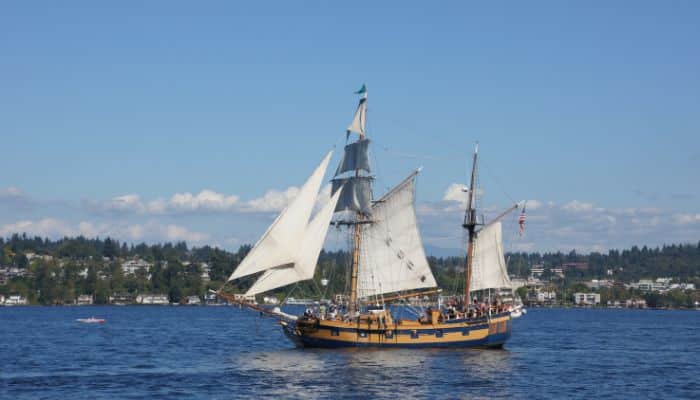
The mizzen sail rests on the mizzen mast. In general, the mizzen mast is slightly shorter than the main mast.
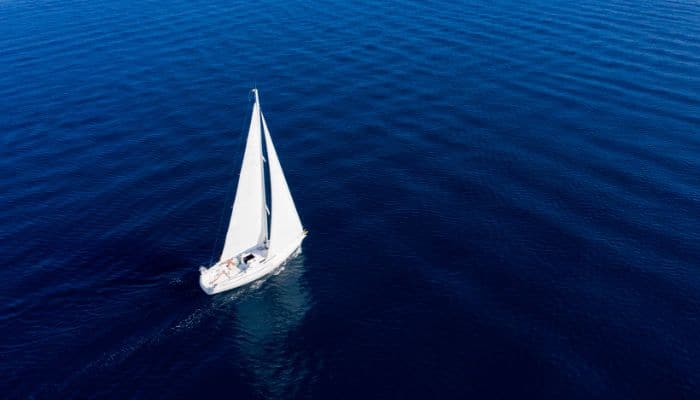
The main mast supports two sails known as the mainsail and the headsail.
The schooner is another configuration similar to the ketch, but where the aft mast is taller than the foremast.

Schooners can have multiple masts and are not restricted to commercial small and medium sailboats. The images of ancient ships that were used for trade and military purposes were often schooners having between four to six masts with an average of over ten sails each.
In addition, the sails of the schooner tend to lie along the length of the vessel, rather than along the beam. This is to prevent sail rupture during violent storms or during heavy winds. The catboat is one of the simplest configurations where only a single sail and mast arrangement are used.
The mast can be located either aft or fore of midships, with varying advantages to each configuration. The ease of design and construction makes it a favourable sailboat for beginners and trainees. However, the disadvantage behind the catboat is that the sail cannot be used to move against the direction of the wind, unlike other sail variations.
Apart from recreation purposes, sailboats are one of the most common types of vessels used in recreational purposes and competitions. They can vary in the hull, keel and sail configurations based on the primary purpose that they are intended to be used for.
For over five thousand years, sailboats have been in use, whether it has been for transportation in Ancient Egypt, or for sailing events in modern times. Technological advancements have turned the sailboat into a sleek, agile and fast vessel capable of reaching extremely high speeds by harnessing the power of the wind.
Whether it be for cruises or for racing events, sailboats and other such crafts continue to be a favourite choice for sailors.

Frequently Asked Questions About Sailboats
1. how many different kinds of sailboats are there.
There are many types based on their hull type- monohulls, catamarans and trimarans; keel type- fin keel, wing keel, daggerboard, centreboard; mast configuration and sails- sloop, fractional rig sloop, schooner, ketch, yawl, cutters and catch.
2. What is the most common type of sailboat?
The sloop is the most common sailboat. It has a mast, two sails, commonly a Bermuda rigged main and a headsail. They include a gaff rig, a mix of gaff and square rig or a Bermuda rig.
3. What is a four-masted sailboat called?
It is called a schooner. Traditional schooners have a gaff-rig, which means that they have a square topsail on the front of the mast. They were mainly constructed for carrying cargo, passengers and for fishing.
4. How many masts does a ketch have?
Ketch has two masts whose main mast is taller than the mizzen mast. It is similar to a yawl and has a triangular mizzen sail and a triangular or square headsail. Due to their smaller sails, they are easily manageable and preferred by sailors.
5. What is the most beautiful sailboat?
Some of the most beautiful sailboats in the world include Pelagic Australis, Thomas W Lawson, Royal Clipper, Barque Sedov and Amerigo Vespucci.
6. What are some popular sailboat brands?
Beneteau, Sparkman and Stephens, Oyster Yachts, Amel Yachts and Nautor’s Swan are some popular sailboat brands that sell the most number of sailboats yearly.
You Might also like to read
- Real Life Accident: Officer Of The Watch Ignores Lookout’s Warning, Ship Collides with Sailboat
- Introduction To Different Types Of Yachts
- 12 Sailing Books For Beginners
- The Ultimate Guide to Different Types of Boats – Top 20
- Main Types of Catamarans Used in the Shipping World
- What are Tug Boats – Types And Uses
Disclaimer : The information contained in this website is for general information purposes only. While we endeavour to keep the information up to date and correct, we make no representations or warranties of any kind, express or implied, about the completeness, accuracy, reliability, suitability or availability with respect to the website or the information, products, services, or related graphics contained on the website for any purpose. Any reliance you place on such information is therefore strictly at your own risk.
In no event will we be liable for any loss or damage including without limitation, indirect or consequential loss or damage, or any loss or damage whatsoever arising from loss of data or profits arising out of, or in connection with, the use of this website.
Do you have info to share with us ? Suggest a correction

About Author
Ajay Menon is a graduate of the Indian Institute of Technology, Kharagpur, with an integrated major in Ocean Engineering and Naval Architecture. Besides writing, he balances chess and works out tunes on his keyboard during his free time.
Read More Articles By This Author >
Related Articles
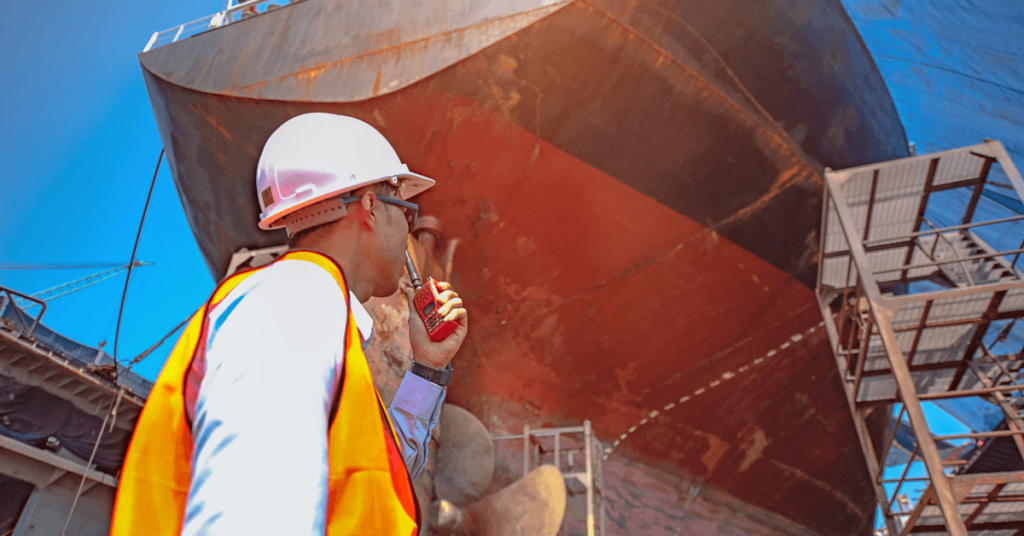
9 New Aspects of IACS Harmonised Common Structural Rules (CSR) For Ships
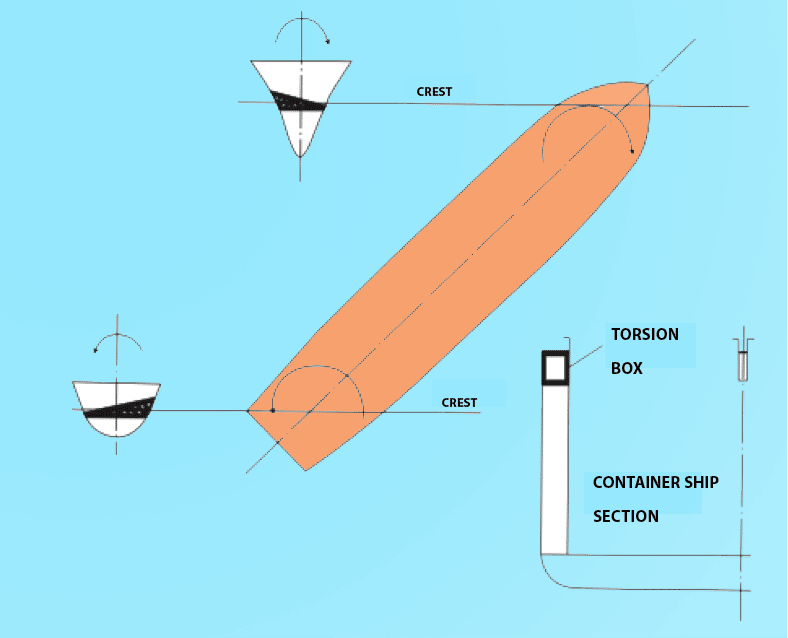
What Is The Purpose Of “Torsion Box” In Ships?
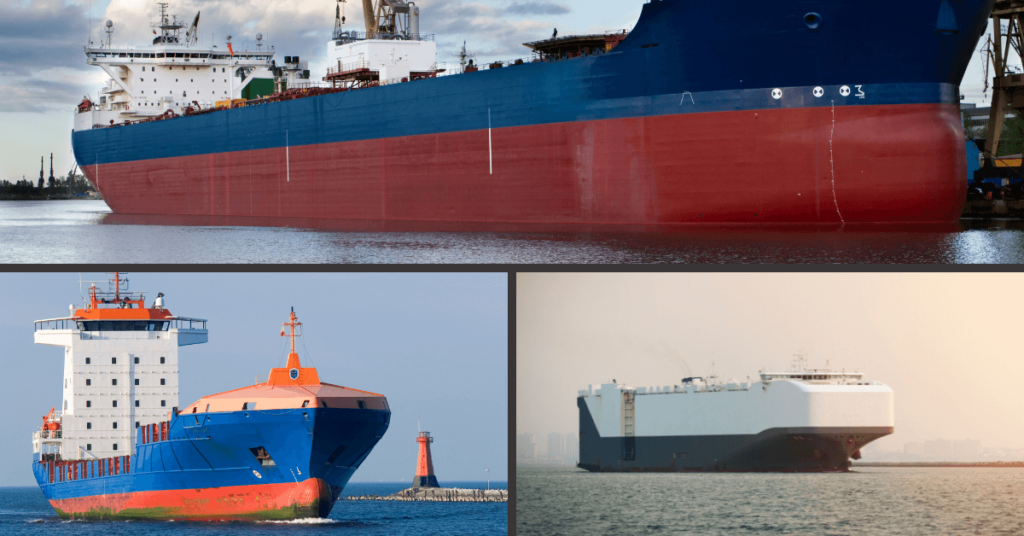
Types of Bow Designs Used For Ships
Daily maritime news, straight to your inbox.
Sign Up To Get Daily Newsletters
Join over 60k+ people who read our daily newsletters
By subscribing, you agree to our Privacy Policy and may receive occasional deal communications; you can unsubscribe anytime.
BE THE FIRST TO COMMENT
Leave a reply.
Your email address will not be published. Required fields are marked *
Subscribe to Marine Insight Daily Newsletter
" * " indicates required fields
Marine Engineering
Marine Engine Air Compressor Marine Boiler Oily Water Separator Marine Electrical Ship Generator Ship Stabilizer
Nautical Science
Mooring Bridge Watchkeeping Ship Manoeuvring Nautical Charts Anchoring Nautical Equipment Shipboard Guidelines
Explore
Free Maritime eBooks Premium Maritime eBooks Marine Safety Financial Planning Marine Careers Maritime Law Ship Dry Dock
Shipping News Maritime Reports Videos Maritime Piracy Offshore Safety Of Life At Sea (SOLAS) MARPOL
WAIT! Did You Download 13 FREE Maritime eBooks?
Sign-up and download instantly!
We respect your privacy and take protecting it very seriously. No spam!
WAIT! Did You Download 12 FREE Maritime eBooks?

SailingEurope Blog - Sailing, Yacht Charter and Beyond
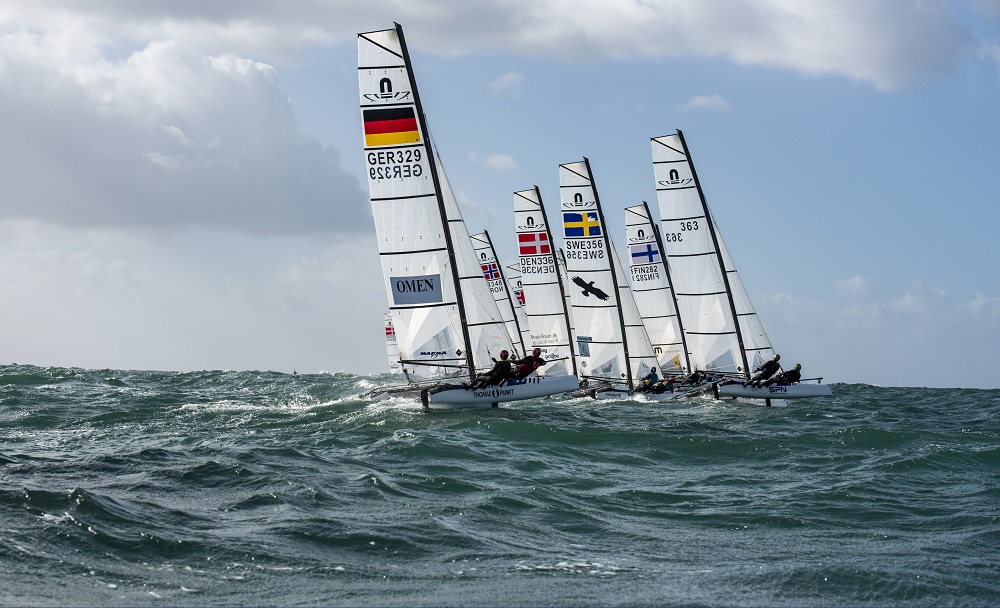
Sailboat Racing And Regattas
Sailboat racing basics and tips.
Now that you’ve learned the basics of sailing , started using sailing quotes in your everyday speech and learned how to tie sailor knots , it is time you take things on the next level and start participating in sailboat racing (sailboats races) or regattas .
Sailboat racing has its origins in Holland and from there, it was introduced into England and American colonies of the 17 th century. Back then, the members of yacht clubs would join together and organize all sorts of competitions for social and recreational purposes. One of them were sailboats races. One of the oldest international sailboat racing events is America’s Cup .
What Is A Regatta?
Nowadays, a sail boat race is the same as a regatta. They can be professional or amateur, charitable or just for fun. Regatta consist of individual races, where the overall winner is the crew that performs best in the majority of the races. There are different types of regattas and there is a great variety of sailboats for racing.
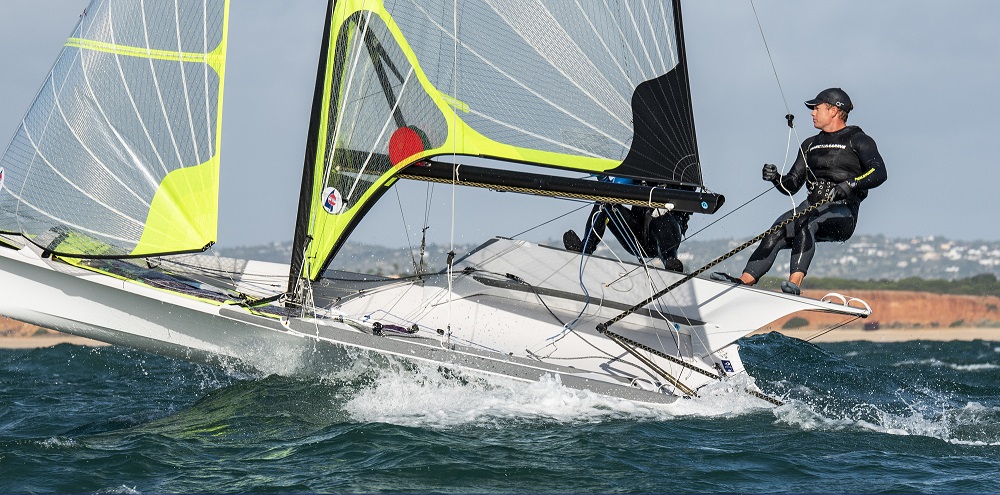
One of the most common divisions is to:
This type of race is the most common in the world of sailing. There are two main formats of fleet racing. The first one is a “one-design” format that requires that all sailboats belong to the same class. The second one is a Performance Handicap Racing Fleet (PHRF) that allows sailboats to be from different classes. In the second format the aim is to play fair, which means that faster boat classes need to give advantage to the slower ones and start racing later. Fleet racing doesn’t have a set duration.
In a match race there are two identical sailboats that are competing against each other. The rules are simple – the first boat to cross the finish line is the winner. However, since the boats are identical, there are lots of tactics that needs to be employed by the sailors in order to win. This is one of the shortest sailboat races , lasting only 20 minutes.
When team racing, there are, as the name indicates, two teams racing against each other. There are usually two to four boats per team. The winner of a team race isn’t solely the team that is the first one to cross the finish line, but the points are added to each sailboat . The important thing is that the team that has less points is the one to win, so the first one to cross the finish line earns one point, the second one two points exc. This sailboat race lasts only around 10 minutes.
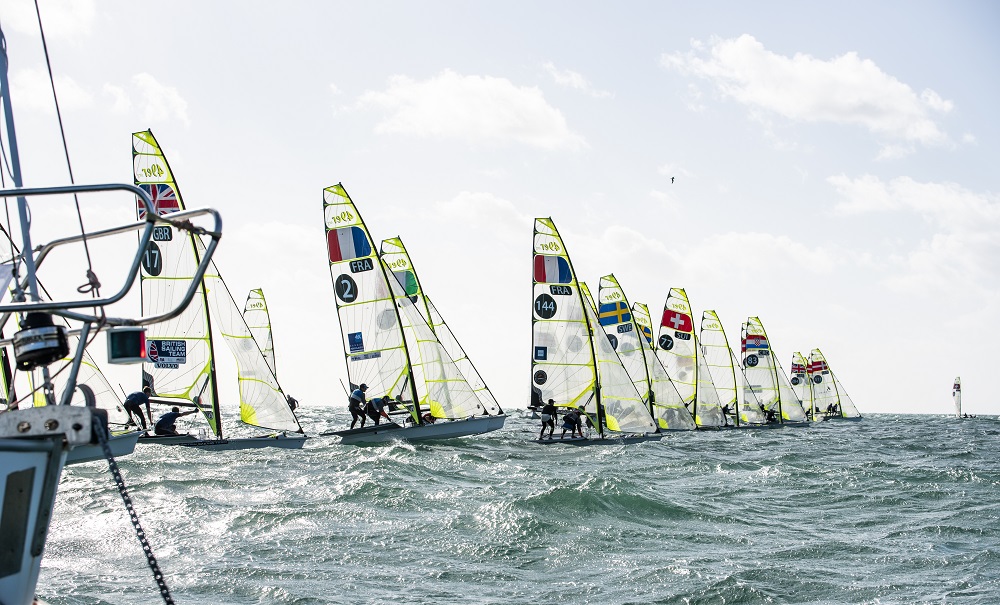
Other Types of Regattas
Speed sailing.
A discipline where the main goal is to sail a vessel as fast as possible. The overall speed is then being recorded (it is measured in knots). Windsurfing and kiteboarding are the most popular in this category.
Regatta around the buoys
Usually held in a regatta field. The rules are simple – there is a determined number of buoys that boats have to sail around.
Navigational regatta
Or so-called ocean racing is usually around larger areas, such as islands, even continents. This is quite a dangerous sport since it alludes to long-distance solo sailing.
Other than that, there is a great variety of boats for sailing races, for example dinghies, large yachts, catamarans, race boats exc.
What Are The Basic Racing Rules?
The Racing Rules of Sailing are updated and published every 4 years by World Sailing. The current ones are The Racing Rules of Sailing 2017-2020. Their aim is to preserve safety of sailors and boats, and also to guarantee fair competition. They are governed by two basic principles:
Sportsmanship and the Rules
Sailing, just as any other sport, has prescribed rules that need to be followed and enforced. Competitors must respect a fundamental principle of sportsmanship, which means that if they break a rule, they will be a penalty (which in some cases means retirement).
Environmental Responsibility
Competitors in sailboat races are also responsible for the environment, in this case for the water. They need to minimize any negative impact that the sport could have on the environment.
The rules in racing are important, but following them isn’t the only way that leads to winning. It is also important to learn the tactics. You have to be aware that the weather might not be perfect, there could be waves, wind and other unpleasant weather conditions . Good tacticians will know how to maneuver the boat in every situation and will know how to make the best out of the worst. This, of course, requires a lot of practice and experience. But don’t be discouraged because nothing is impossible to those who are determined to succeed.
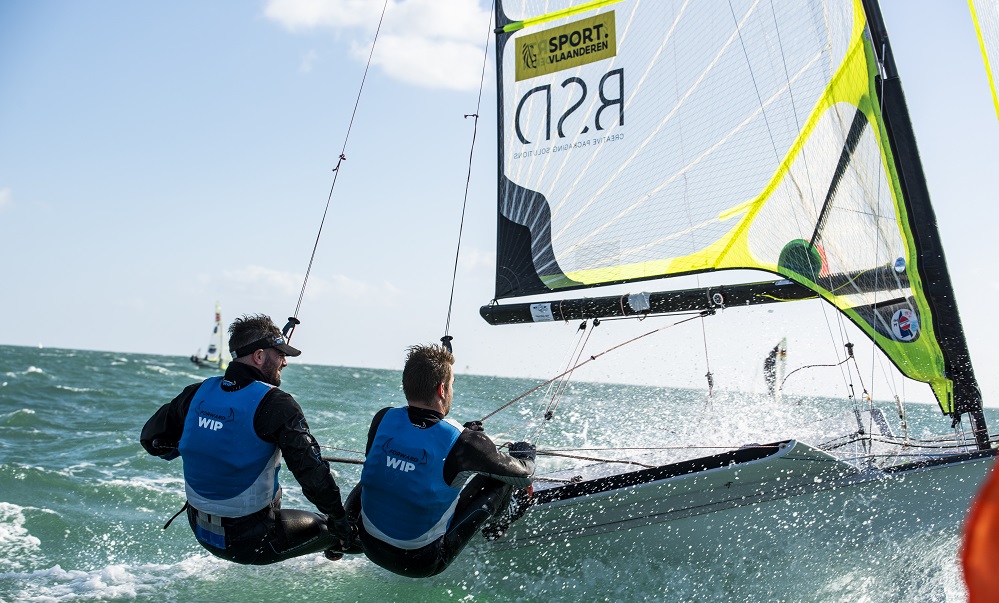
How To Prepare And What To Pack For Sailboat Racing?
When planning a sailboat race, you need to take into account that you will be working hard and therefore you need to prepare physically . The last thing you want during a regatta is a sore body so go ahead and run, visit the gym, lift weights and prepare your muscles before you head to the sea. Other than preparing your body, you need to have the right mindset . The most important thing is to stay focused on your goal.
After you’ve prepared yourself physically and mentally, you need to pack .
Clothes wise, you’ll need:
Sailing gloves, pants (long and short), t-shirt and long sleeve shirt, non-slip shoes, sailing suit, waterproof jacket, bathing suit, cap or hat.
Other necessities are:
Sunscreen, sunglasses, towels, personal hygiene items, mosquito repellent, personal medications.
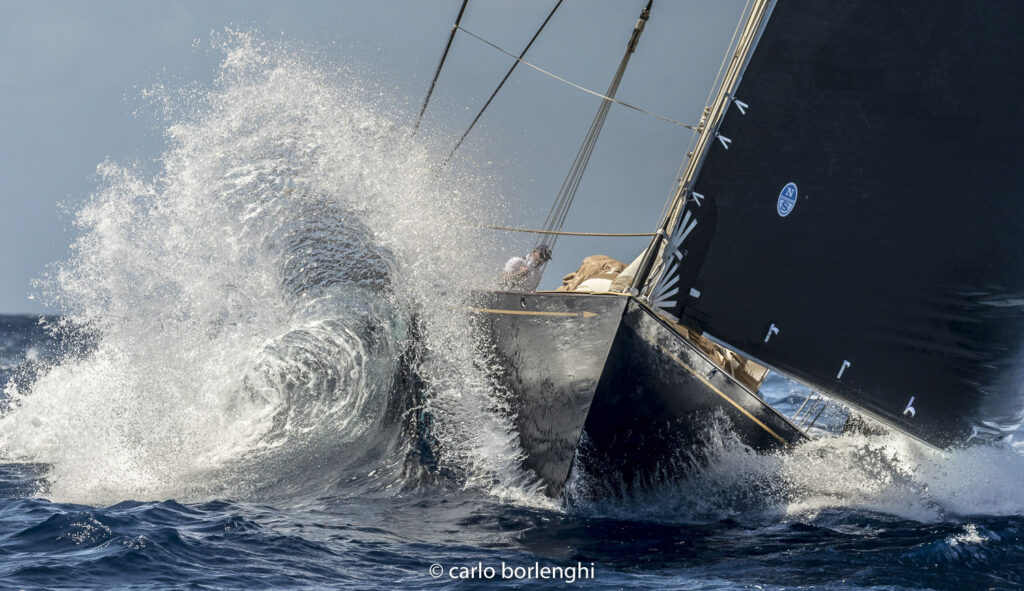
Most Popular Regattas
America’s Cup – regatta around the buoys Volvo Ocean Race – navigational fleet race The Kiel Week or Kiel Regatta – the largest sailing event in the world, held in Germany
You can find more about the most prestigious regattas in the world in our two part article: Most Prestigious Regattas in The World 1 Most Prestigious Regattas in The World 2
Sailboat racing is also an Olympic discipline and has been part of the Olympic Games since 1900. Olympic sailors compete in nine classes.
Sailboat Racing (Regattas) In Croatia
Gladuša – the most popular spring regatta, it usually starts mid-April on Dugi Otok Fiumanka – the biggest regatta in the northern Adriatic, every June in Rijeka Južnodalmatinska regata – the most popular summer regatta, every August, lasts four days, the sailing route includes the city of Dubrovnik, as well as islands of Mljet and Orebić Mala noćna regata – a cool, relaxing night regatta in mid-August on the island of Brač Viška regata – ideal regatta for the end of the season, in October, the sailing route includes the city Split and the island of Vis Aj, Ti Regatta – SailingEurope’s regatta which gathers the experts form IT sector
Croatia Is A Common Host To World’s Famous Sailboat racing Championships, Such As:
ORC World Championship – a sailing competition held in Šibenik, Croatia (31.05.-08.06.2019.) Adris 44Cup – one of the most interesting sailing races (a series of five regattas in five different locations), one of the hosts is the city of Rovinj (28.05. – 02.06.2019.) Barcolana – a massive international regatta with over 2000 sailboats, always in October in Trst
In the end, after you’ve studied the rules, decided on the type of race and prepared yourself, all that’s left is the race itself. Ready, set, go!
1 thought on “Sailboat Racing And Regattas”
I found this article about Boat racing to be incredibly informative and well-researched. The author’s attention to detail and inclusion of relevant examples truly enhances the content and makes it engaging to read.
Leave a Comment Cancel Reply
Your email address will not be published. Required fields are marked *
Save my name, email, and website in this browser for the next time I comment.
This site uses Akismet to reduce spam. Learn how your comment data is processed .

Offshore Racing Sail Names Explained
- July 17, 2023
Table of Contents
Racing sailboats is a thrilling and challenging sport, but it can also be overwhelming for those new to the game. There are countless different types of sails and it can be difficult to know where to start. In this article, we will be discussing the most important racing sail names that every sailor should know.
We will also discuss the differences between racing and cruising sails, as well as give a brief overview of common offshore sails such as H1, J1, J2, A1, A2, etc. Whether you’re a seasoned racing sailor or just starting out, this guide will provide you with the knowledge and confidence you need to take your racing game to the next level.
Sail Size A Shape Determine A Racing Sail Name
Sail size is a critical component of any racing sailboat, as it plays a major role in determining the speed and performance of the vessel. The size of a sail is dictated by the type of boat and rig, with some masts designed for large genoa headsails and smaller mains, while others have the opposite. It is important for sailors to understand how sail size impacts the overall performance of their boat, particularly when it comes to handicap systems such as PHRF (Performance Handicap Racing Fleet).
When it comes to club racing, sailors must declare their sail sizes to the handicap system. This is where knowing the LP (luff perpendicular) and girth measurements of your sails becomes crucial. Many casual racers may find mistakes on their certificates when they take a close look, so it is important to work with a sailmaker to ensure that these measurements are reported correctly.
Making adjustments to sail size can also have a significant impact on speed and rating. For boats that are chronically underpowered, a bigger genoa can help. On the other hand, if a boat is often overpowered, a smaller jib can help reduce the amount of tipping and result in a more favorable rating. Similarly, a mainsail with a smaller girth than what is listed on the rating certificate may be entitled to a few seconds per mile of rating benefit.
Understanding Racing Sail Shapes
Sail shape is another important factor to consider when it comes to racing. A sail’s shape can become distorted over time, which can lead to a loss of efficiency and speed. To ensure that your sails are in the best shape possible, it’s important to regularly identify the shapes of your current sails and make adjustments as needed.
One of the best tools for identifying sail shape is a camera. Take photos of your sails from as low as possible at the mid-foot, looking up, and share them with your sailmaker. These photos will allow your sailmaker to see the overall draft, leech profile, and other important details of your sails.
As sails age, the overall draft tends to move too far aft, and the leech profile opens up in the high-load middle and upper sections. Both of these changes make the sail less efficient, which can lead to slower speeds. If your photos show this type of distortion, it’s a good idea to start budgeting for a new sail. Starting with the sail that you use the most, such as your genoa, is a good place to begin.
It’s also important to monitor your sails’ shapes over time. Every season, take the same sail shape photos and share them with your sailmaker. This will allow you to see how your sails are changing and make adjustments as needed. If your sailmaker isn’t interested in looking at photos of your existing sails, it may be time to find a new sailmaker.
Common Offshore Racing Sail Names
When it comes to racing, having the right sails for the conditions can make all the difference in the world. As a sailor, it’s important to know the different types of sails available to you, and how to use them to your advantage. One of the most important factors to consider when choosing a sail for racing is whether it’s an offshore sail or not.
Offshore sails are typically made from stronger and more durable materials than inshore sails, and are designed to withstand the harsh conditions of open water. They are also often built with a more aggressive shape, to provide the maximum amount of power and speed.
One of the most common offshore racing sail names you’ll hear is the Heavy 1 (or H1). This is a heavy weather headsail that’s typically used in strong winds and rough seas. It’s made from a strong, durable material, and is designed stability in heavy winds.
Another common offshore sail is the J1. The J1 is a jib that’s often used in medium to heavy winds. It’s designed with a relatively flat shape, to provide a balance of power and stability. The J2 is similar to the J1, but it’s designed for use in even heavier winds.
The A1 and A2 are also common offshore sails. The A1 is a heavy weather spinnaker that’s typically used in strong winds and rough seas. It’s made from a strong, durable material, and is designed with a deep draft to provide maximum power and stability in heavy winds. The A2 is similar to the A1, but it’s designed for use in even heavier winds.
When choosing offshore sails, it’s important to consider the conditions you’ll be sailing in, as well as your own skill level and the capabilities of your boat. Be sure to consult with a sailmaker or other experienced sailor to help you make the right choice. With the right offshore sails, you’ll be well-equipped to take on any challenge that the open water may throw your way.
Final Thoughts
In conclusion, understanding sail size and shape is crucial for club racing sailors looking to optimize their performance on the water. By knowing the LP and girth measurements of your sails, as well as keeping an eye on their shape over time, you can make informed decisions about your sail inventory and ensure that you have the right sails for the job.
It is important to work with a sailmaker who can help you understand these concepts and make the necessary adjustments to your sails. They will be able to advise you on the best sizes and shapes for your boat and rig, as well as any changes that may be needed as your sails age.
In addition, being familiar with common offshore racing sail names such as H1, J1, J2, A1, A2 etc., and understanding how they are typically used in different types of races and conditions can also be beneficial to your performance.
By following these guidelines, you can ensure that your sails are optimized for performance, and you can enjoy the thrill of club racing to the fullest. So, get out there on the water and let the wind take you to the finish line!
And if your sails start to look more like trapezoids than triangles, just head over to SailTrader and pick up some new ones. We’re the largest marketplace exclusively dedicated to sailboats, so you’re sure to find any type of sail you’re looking for!
The Sailor’s Marketplace for Sailboats and Sails.
Sell Your Sailboat
Sailboats for sale.
- New Sailboats
- Used Sailboats
- Cruising Sailboats
- Racing Sailboats
Sell Your Sails
Sails for sail, sail manufacturers.
- North Sails
- Quantum Sails
- Doyle Sails
- UK Sailmakers
Sailing Reviews
- Sailing Line
- Safety Equipment
- Sailing Accesories
As an Amazon Associate SailTrader earns from qualifying purchases.
This website uses cookies to ensure you get the best experience possible.

- [ May 20, 2024 ] Arrests In Brevard County: May 20, 2024 – Suspects Presumed Innocent Until Proven Guilty Brevard Crime News
- [ May 20, 2024 ] WATCH LIVE: Eau Gallie High School Holds Class of 2024 Graduation Ceremony at King Center Brevard News
- [ May 20, 2024 ] WATCH LIVE: Satellite High School to Hold Class of 2024 Graduation Ceremony Brevard News
- [ May 20, 2024 ] WATCH LIVE: Astronaut High School Holds Graduation Ceremony for Class of 2024 Brevard News
- [ May 20, 2024 ] WATCH LIVE: Bayside High School to Hold Class of 2024 Graduation Ceremony Brevard News
Home » Home » IT’S RACE WEEK! Thunder on Cocoa Beach Offshore Powerboat Race Festivities Underway
IT’S RACE WEEK! Thunder on Cocoa Beach Offshore Powerboat Race Festivities Underway
By Space Coast Daily // May 19, 2024
Enjoy four days and nights of parties and lots of racing action!
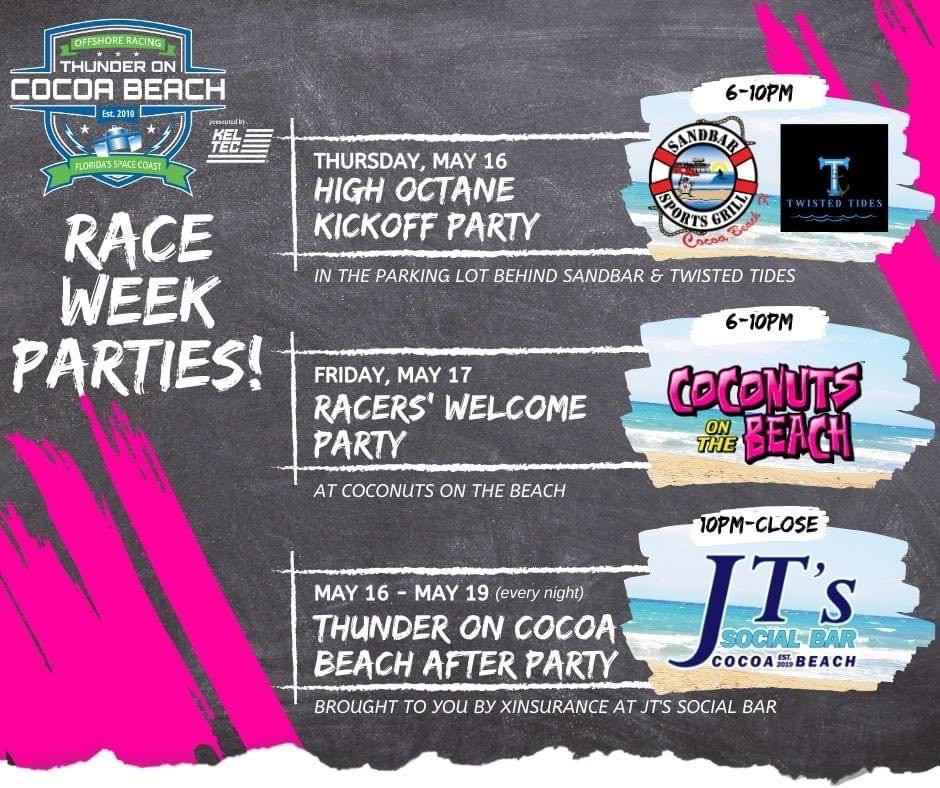
It’s Race Week! Don’t miss any of the pre-race party events. You do not have to be a VIP ticket holder to attend these parties—they are open to the public! Tonight High Octane Kickoff Party behind Sandbar Sports Grill – Cocoa Beach Friday night’s Thunder on Cocoa Beach Block Party (in downtown Cocoa Beach) and the Racers’ Welcome Party at Coconuts On the Beach and the official Thunder on Cocoa Beach After Party each night at JT’s Social Bar.
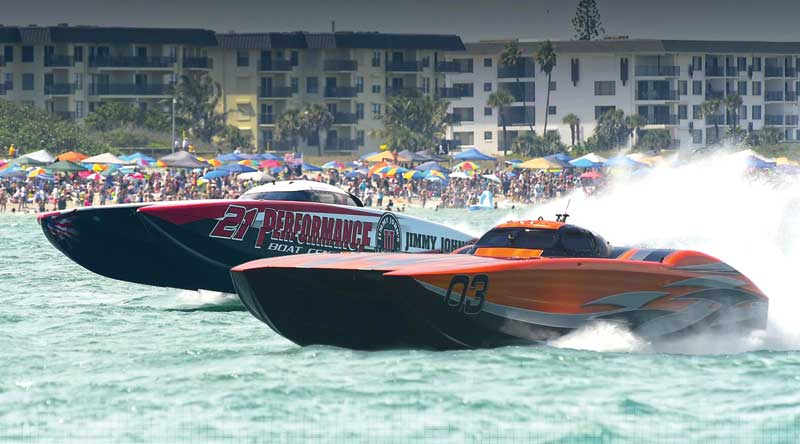
BREVARD COUNTY • COCOA BEACH, FLORIDA – Thunder on Cocoa Beach offshore powerboat races will return for its 15th year on Florida’s Space Coast, scheduled from May 16 to May 19 and includes four days and nights of parties and lots of racing action.
The Space Coast Super Boat Grand Prix is one of the most popular attractions for the whole family in Central Florida and draws the top race teams in the World to compete in various classes with Class 1 reaching speeds over 175 mph.
In addition to soaking up the vibe of a Powerboat P1 race filled with excitement, action and speed, spectators can also take in the atmosphere of the East Coast’s surfing capital.
Due to its warm weather, steady waves and world-class surf shops, Cocoa Beach welcomes around 2.5 million visitors each year , making it a top tourist destination. Once the racing is over, The Cover will be a popular destination, with Fish Lips Waterfront Bar & Grill on everyone’s list.
Class 1 is the premier class of offshore powerboat racing in the world and is considered to be one of the most spectacular marine motorsports.
A Class 1 race boat has twin inboard 1100 horse power engines. Each boat has a two-man crew: the driver and throttleman. They work closely with their pit crews to decide the race set-up: the type of propeller required for the conditions, gear ration settings, the amount of fuel needed and race tactics.
For tickets go to ThunderOnCocoaBeach.com
All-New VIP Experience
A great race day experience is available for the biggest race fans as 2024 will usher in an all-new VIP experience for Thunder on Cocoa Beach fans.
Thunder on Cocoa Beach race officials said this year it’s all about where to be on Saturday and Sunday for race days.
“We have completely upgraded our VIP experience to offer a better experience and to enhance how and where you watch the race. You have more options for seating, dining and drinking for two fantastic days of racing – we’ve even included an option to pre-pay for VIP parking at Lori Wilson Park.”
For 2024, the only location for beach chalets is at the start/finish line located at Lori Wilson Park; there will not be chalets on the turns. For viewing options this year, you can choose from a VIP chalet ticket, a two-person lounger with umbrella ticket or amp up your weekend in one of our private cabanas.
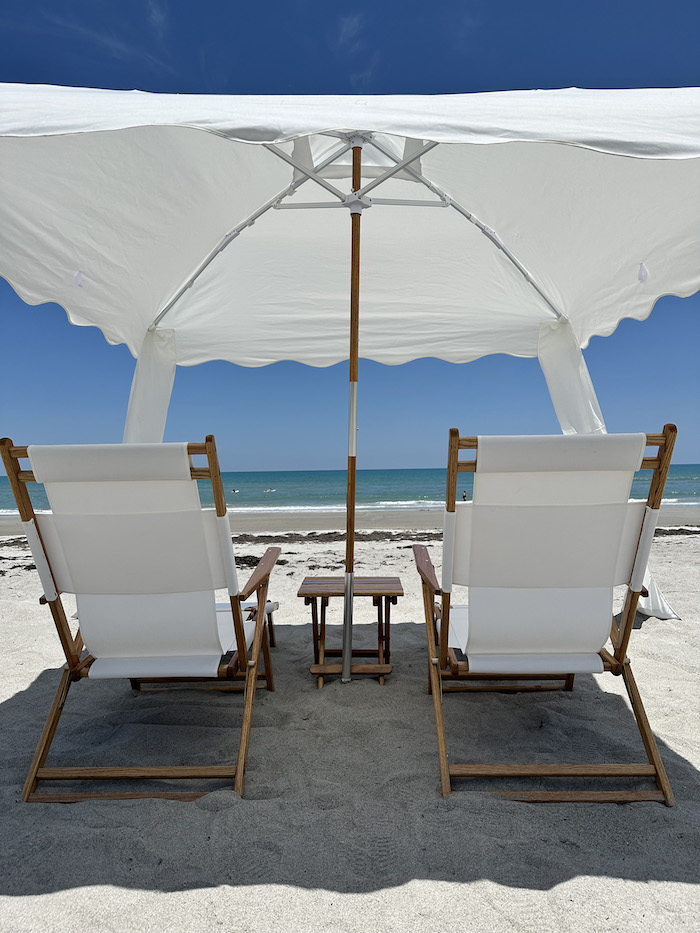
VIP CHALET: The Thunder on Cocoa Beach VIP Chalet is getting a makeover. It will feature a dining area and cozy VIP lounge spaces. Sit and watch the race on LIVE TV in total comfort under our large, shaded tent and enjoy a complimentary buffet and two drink tickets. A cash bar will also be available.
TWO-PERSON LOUNGER WITH UMBRELLA: The two-person lounger chair set up with umbrella gives you a dedicated spot to watch the race without having to lug your own chairs and umbrellas. Each setup accommodates two people and includes table service. These tickets include access to the VIP Chalet and all the perks that accompany the VIP Chalet ticket.
PRIVATE CABANA: Sit in the middle of the action in your own private cabana. The two-person private cabana comes with two canvas loungers, a cocktail table, UV cabana shade, dedicated food/drink server, towel service, two drink tokens and a plate of food for each person. Got friends? You can add two more people to your cabana for an upgrade charge. Cabanas also include access to the VIP Chalet and all the perks that come with it.
PARKING: Parking is not included in the price of your ticket, but it can be added to your experience. This year VIP parking passes will be sold ahead of race day and are only valid with a TOCB VIP ticket.
There is a new location for Thursday night’s High Octane Kick-off Party. You can join the race directors, racers and other fans to celebrate the upcoming weekend’s races in the parking lot behind Sandbar Sports Grill and Twisted Tides.
As always, the race boats will parade down A1A on Friday afternoon at around 4 p.m. headed to the Thunder on Cocoa Beach Block Party located in the streets of downtown Cocoa Beach.
SCHEDULE OF EVENTS
Thursday, May 16 – 6 p.m. to 10 p.m.: High Octane Kick-Off Party behind Sandbar & Twisted Tides ; 10 p.m. – Thunder on Cocoa Beach After Party brought to you by Xinsurance at JT’s Social Bar, inside the Cocoa Beach La Quinta Inn.
Friday, May 17 – 9 a.m, to 5 p.m .: Registration and Inspection, Race Village-Racer Village, Flounder Drive; 4 p.m. to 5 p.m. – Boat Parade, boats leaving from the ]ort between 4 p.m. and 4:30 p.m. to park in downtown Cocoa Beach; 5 p.m. to 10 p.m. Thunder on Cocoa Beach Block Party in Downtown Cocoa Beach and meet the racers; 6 p.m. to 10 p.m. Coconuts on the Beach VIP party; 10 p.m., Thunder on Cocoa Beach After Party brought to you by Xinsurance at JT’s Social Bar, inside the Cocoa Beach La Quinta Inn.
Saturday, May 18 – 10 a.m. to 4 p.m., VIP Experience Start/Finish Line at Lori Wilson Park; 10 a.m. to 5 p.m. Power Boats in Dry Pits, Race Village Flounder Drive; 10 p.m., Thunder on Cocoa Beach After Party brought to you by Xinsurance at JT’s Social Bar, inside the Cocoa Beach La Quinta Inn.
Sunday, May 19 – 9 a.m. to 4 p.m., Launching at Scorpion Marine; 10 a.m.to. 4 p.m., Power Boats in Dry Pits at Race Village on Flounder Drive; 10 a.m. to 4 p.m., VIP Experience Start/Finish Line at Lori Wilson Park; 10 a.m., Start of first race; 6 p.m., Awards Presentation; 10 p.m., Thunder on Cocoa Beach After Party brought to you by Xinsurance at JT’s Social Bar, inside the Cocoa Beach La Quinta Inn.
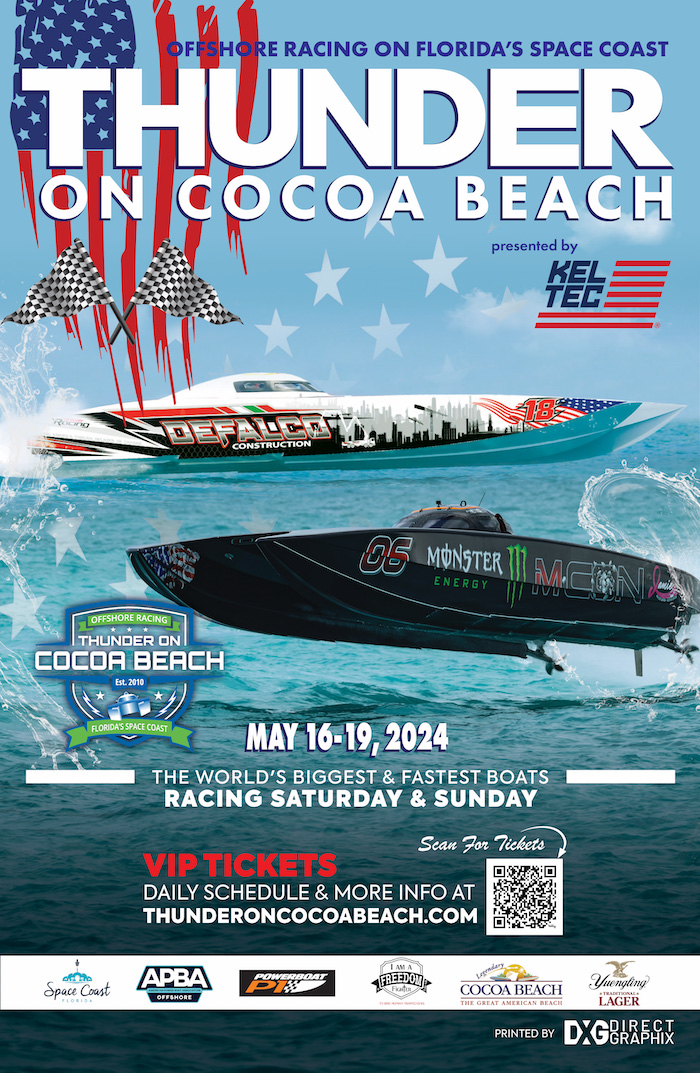
Similar Stories
FEATURED STORIES

Click Here to Sign Up for Text Alerts
Or Signup Below For Email Alerts!

Best 2 Person Sailboats

Last Updated by
Daniel Wade
December 28, 2023
Key Takeaways
- 2-person sailboats are small sailboats like sailing dinghies but can be a larger boat too
- Experienced sailors will likely not need much of nay training on these boats
- Most of these boat types are trailerable sailboats since they are under 30 feet
- 2-person sailboats are some of the best sailboats but it varies on your intended use
- Consider joining a sailing club to get the most use out of 2-person sailboats
A 2-person sailboat can be a larger dinghy or a sailboat meant to be handled by two people. But what are some of the best 2-person sailboats?
The RS200, Hunter 15, and Hobie 16 are a few of the best 2-person sailboats. Other sailboats meant for two people include the Norseboat 17.5, Sunfish, and even a Laser SB3. These small sailboats are best geared as a beginner sailboat that compliments having two people on board.
In my experience, there are plenty of small sailboat brands that are perfect dinghy sailors or those that want to have an extra person on board their boat. Whether it is a big boat or small boat there are options to have at least two people on board while sailing.
Table of contents
Top 12 Best 2-Person Sailboat Brands
When people think about a two person sailboat they often refer to a small sailboat. Indeed a sailing dinghy is likely your best bet but there are other options to consider when looking for a fun cruising sailboat that can accommodate another person.
{{boat-info="/boats/rs-sailing-rs-200"}}
The RS200 is considered one of the most popular double handed dinghies in existence. Since 1995 it has become a staple for those that want to enjoy or get into dinghy sailing.
The use of two people makes it a great experience on the water and necessary to help navigate. If you have never sailed on one of these you are missing out on a thrilling experience.
{{boat-info="/boats/hunter-15"}}
One of the more affordable small sailboats best for two people out there is the Hunter 15 . It is perfect for sailors that are getting their feet wet or only go out every so often without worrying about messing with complicated features. While it can hold up to four people it is best suited for two in mind to help sail.
{{boat-info="/boats/hobie-16"}}
The Hobie 16 is one of the most famous multihull sailboats for those that enjoy a sailing dinghy. The fact that it incorporates a second person to help steer makes it a fun and rewarding experience with a friend on board. In fact having another person on board will help unlock its true sailing potential.
Norseboat 17.5
{{boat-info="/boats/norseboat-17-5"}}
For those that love a good daysailer it would be difficult to pass up a Norseboat 17.5 if you saw one for a good price. These are perfect for a couple to enjoy an evening out on the water or to gently explore shallow waters. In some cases you could enjoy fishing if the water is calmer.
{{boat-info="/boats/vanguard-sunfish"}}
The Sunfish is another classic small sailboat that is great for having two people on board. They are famous for being used in racing events across the world. They are easy to sail and are right around 14 feet in length which make them easy to transport.
{{boat-info="/boats/laserperformance-laser-sb3"}}
Laser sailboats are another iconic sailboat brand that features the ability to have two people on board. With the added weight of another person it increases the performance of this boat while racing. It is also great for building camaraderie among other sailing racers on a team.
West Wight Potter 19
{{boat-info="/boats/west-wight-potter-19"}}
West Wight Potter has made a few popular cruising sailboats over the years with most notably their 19 model. This boat is a brick house for around 19 feet and is easy to sail with another person on board. Even though these are not as fast as some of the other sailboats mentioned here it makes up for that with the added level of comfort to accommodate another guest.
Catalina 16.5
{{boat-info="/boats/catalina-16-5"}}
Catalina is known for their quality and craftsmanship of sailing yachts. There is plenty of room in the cockpit for two people to enjoy an afternoon together.
It is also a great option for a daysailer. Some of the larger models are considered a family boat but can also be used by just two people due to its ease of use while sailing.
The 420 is another edition of a sailing dinghy that is meant for two people. If you see a sailing dinghy that is not a Sunfish then this is usually the next option for sailors. It offers style and an endless opportunity to have excitement on the water.
{{boat-info="/boats/chuck-paine-paine-14"}}
The Paine 14 is considered a mini yacht and is a perfect trailerable sailboat. The boat’s design is great for accommodating another person on board. It is great for those new to sailing or want a smaller boat with a classic look.
{{boat-info="/boats/sage-marine-sage-17"}}
For pocket cruisers you cannot ignore the Sage 17 as a great option for two people on board. This fractional sloop is perfect in shoal drafts and is ideal for those that want to have a relaxing environment. It is stable and offers a great experience on the water no matter where your adventures take you.
Islander 24
{{boat-info="/boats/islander-24"}}
The Islander 24 is perfect for those that do not want a larger sailboat but also do not want a dinghy. It is a perfect blend for sailing and cruising but also providing many opportunities on the water. With its size you can easily navigate this boat with two people.
Why Are 2-Person Sailboats Great Boats?
No matter what your desired sailing adventure is there are plenty of sailboats that are geared towards an easy setup and sailing experience. For boats that are designed with two people in mind it makes it sound like it is more difficult to handle but that is not the case.
Boats that are capable for two people sailing can generally be handled by one person but the performance is improved with the addition of the second person. The type of boat will also make a difference and if it has anything equipped such as automation systems. Below are some reasons why these boats are best for beginners or those that want an easier time on the water.
Sailing is Easier
Dinghies usually are meant for racing but they offer you first hand experience on how a boat should move in the water. Do not be afraid of the occurrence of capsizing in these boats.
In fact it is an integral part of the experience that will give you real time feedback on what went wrong. As for pocket cruisers or daysailers you do not want to capsize these so make an effort to control the stability as best as you can.
Rigging Setup is Seamless
For smaller boats that you can move on a trailer they usually can be put together in pieces. This makes setting up and breaking down a simple process that is great for storage.
When you are sailing and are newer to the experience you want something that is simple while operating in real time. You will likely want to handle something that does not take rocket science to explain.
Compact Size
Bigger sailboats are a little harder to steer so that is why it is best to go for something less than 30 feet with two people. This gives you plenty of room without compromising comfort.
The most ideal size ranges for two people are between 14 and 24 feet but it largely depends on the type of boat you are using. Some sailors can even handle boats ranging 45 feet and up but it all depends on your experience and intended use.
Multiple Sails
The mainsail is all you need to learn the basics of sailing but some boats might be equipped with more sails. This might mean your boat is a sloop rig which has two sails.
If you have more sails it would not hurt to have a second person on board to help with the action of raising and lowering of them. An automation system would greatly help this situation.
Many boats have various options for steering. These include tiller and wheel steering which should be obvious when checking out the boat upon a potential purchase.
If your boat has tiller steering it is best to get a feel for how the boat is while you are sailing. However you should go for what is most comfortable to you when you are the one operating it the most.
Best for Getting Parts
Since some boats are generally smaller for two people that means it is easier to acquire boat parts for maintenance. There are more boat parts in stock for smaller boats since they are more common which means you will have less of a headache and downtime for sailing.
There might even be a good chance you can find them cheaper on a marketplace online. Some boats might be totaled at a shipyard and you can find parts cheaper than paying for new ones outright.
Best Prices
Since 2-person sailboats are generally smaller they are usually are less expensive than other larger boats. If you are able to find them used they are even better at fitting within your budget depending on that boat brand.
You can expect to pay less than $20,000 for many top quality 2-person sailboats. This all depends on the condition of the boat and how new it is upon you purchasing it. This could range much higher depending on additions to the boat and the brand.
Are 2-Person Sailboats Good for Families?
As the name suggests it would not really be ideal to have a boat that is meant to hold only two people. But some of the options mentioned above are large enough to hold roughly four people and are great for the family.
Depending on how you intend to use your sailboat can make a difference as well. Some boats can still be considered family boats if they are commonly used within the family.
What Size is Best for 2-Person Sailboats?
Depending on the activity you are going to experience on the water will affect what size boat you are needing. For sailing dinghies those are usually used for racing since speed is priority.
If you are wanting to cruise without having too much else going on then something around 25 feet would be great. Families that are wanting a little more room but still be able to handle the boat with two people can likely find sailboats ranging up to 45 feet that are easy to sail.
There is not really a science that points to the perfect length for 2-person sailing. This all comes down to how confident you are in your sailing abilities and how easy it is to operate the boat in comfortable conditions.
Features to Consider on 2-Person Sailboats
For most one or two person boats there are a handful of features that can make your life easier while sailing. The good news for most 2-person sailboats is that they can likely be operated by one person.
Any added features or design of the boat might make an impact if the other person on board is not used to the setup. Here are some added features that will make a difference but keep in mind that they might not accommodate a small sailboat like a racing dinghy.
System Automation
There are plenty of automatic conveniences to add to your boat. These include autopilot and an electric windlass. A roller furling or even a radar can also make a huge impact to your sailing adventure.
A lot of these features come in handy when the weather turns rough or the tide becomes fierce. It is also great to have these if the other person on board with you is new to sailing or is a small child.
Having a boat equipped with GPS is another option for automation even if you think you know your way around the area. Consider adding one to your boat if you plan on taking it out in moderate conditions that might take you off of the intended path.
Multihulls by default are some of the safest sailboats out there due to their stability. This is true but it also depends on the design of the boat and how it is being used.
Most 2-person sailboats are going to have great stability. If it is a small sailboat that is equipped with a lateen rig it will likely have slightly better stability than other racing dinghies. However pocket cruisers are designed to be more stable and are great for two people wanting to enjoy a cruise.
In the event that something happens you should have a safety tether or a life jacket while on board. Even with two people on board you might not be immune to falling off your boat if the conditions get rough. You should also consider having an emergency radio and a way to ping your location in case things to go bad.
Types of Sails
The sail area on a boat makes a big impact on the performance. This is also why getting the right sails are important.
You should aim to have a combination of a gaff sail and a bermuda sail to optimize performance. Both of these together if applicable are the perfect blend for many windy conditions.
Rigging Setup
There are numerous types of rigs to consider on your boat. A lateen rig has a different shape than a gaff rig and will affect the performance based on the wind.
A gaff rig is best for one or two people on board due to it being easier to sail with an easier set up. No matter what rig setup you have you should know how to properly set up the sails and safely operate while in motion.
Related Articles
I've personally had thousands of questions about sailing and sailboats over the years. As I learn and experience sailing, and the community, I share the answers that work and make sense to me, here on Life of Sailing.
by this author
Best Sailboats
Most Recent

Affordable Sailboats You Can Build at Home
September 13, 2023

Best Small Sailboats With Standing Headroom
Important Legal Info
Lifeofsailing.com is a participant in the Amazon Services LLC Associates Program, an affiliate advertising program designed to provide a means for sites to earn advertising fees by advertising and linking to Amazon. This site also participates in other affiliate programs and is compensated for referring traffic and business to these companies.
Similar Posts

Best Bluewater Sailboats Under $50K

Best Blue Water Sailboats Under 40 Feet

Which Sailboats Have Lead Keels?
June 20, 2023
Popular Posts

Best Liveaboard Catamaran Sailboats

Can a Novice Sail Around the World?
Elizabeth O'Malley
June 15, 2022

4 Best Electric Outboard Motors

How Long Did It Take The Vikings To Sail To England?

10 Best Sailboat Brands (And Why)
December 20, 2023

7 Best Places To Liveaboard A Sailboat
Get the best sailing content.
Top Rated Posts
Lifeofsailing.com is a participant in the Amazon Services LLC Associates Program, an affiliate advertising program designed to provide a means for sites to earn advertising fees by advertising and linking to Amazon. This site also participates in other affiliate programs and is compensated for referring traffic and business to these companies. (866) 342-SAIL
© 2024 Life of Sailing Email: [email protected] Address: 11816 Inwood Rd #3024 Dallas, TX 75244 Disclaimer Privacy Policy

IMAGES
VIDEO
COMMENTS
What are the most common types of racing sailboats? The most-used sailboats for racing are keel boats, centerboard boats (dinghy), multi-hulls (catamaran or trimaran), and tower ship (also called tall ships). Most keel boats are racing yachts between 24' and 50' (7 - 15 m). One of the most well-known sailboat races is the America's Cup 12-meter ...
There are many types of racing sailboats that range from one-man dinghies all the way to 100-foot yachts. Some racing sailboats are classified as keel boats, multi-hull, and even a tower ship. These boats are built primarily for speed, so comfort is usually an afterthought depending on the brand. For racing sailboats, each one is going to fit ...
Yacht racing is a sailing sport involving sailing yachts and larger sailboats, as distinguished from dinghy racing, which involves open boats. It is composed of multiple yachts, in direct competition, racing around a course marked by buoys or other fixed navigational devices or racing longer distances across open water from point-to-point.
F50 catamarans can travel at up to 50 knots. John G. Mabanglo/EPA. A yacht also makes waves as it pushes the water around and under the hull from the bow (front) to the stern (back) of the boat.
3. Team Racing. Team racing can be one of the more exciting types of racing since it involves two teams of 2-3 sailboats racing a course similar to a fleet and match race. While quite similar to a match race in terms of having two teams, the added bonus of having multiple sailboats gives it a bit of nuance. Just like a match race, the sailboats ...
Racing sailboats are generally Spartan on the interior to save weight, since lighter boats travel faster. They have few accommodations, if any, and little attention is paid to comfort or cruising ability. As a result, most true racing sailboats are used strictly for competition and little else. But people have been racing boats just as long as ...
Success in Racing Sailboats. When it comes to racing sailboats, the success lies in the crew being able to perform at a high level. During these intense situations, all of these positions are crucial to the boat going fast and potentially winning the race. These positions are categorized by the skipper, bow, trimmer, and pit.
Racing a sailboat is a lot of fun. It blends the excitement of sailing your own boat with the raw rivalry of trying to beat another boat of comparable size. Racing also teaches you boat handling and sail trim in a manner that cruising cannot: by comparing your speed and handling to those of other boats. Let us jump into the article to learn ...
Racing sailboats can be built specifically for near-coastal sailing around buoys or for offshore distance races. Some offshore races are point-to-point and may have a crew of 10 or more while other races may circumnavigate the globe with only one sailor aboard. ... Boats called racer/cruisers are designed to straddle the two groups above. They ...
Some sailboats share multiple characteristics with other boats but fall into a completely different category. For example, a sailboat with a Bermuda rig, a large engine, and a pilothouse could technically be called a sloop, but it's more likely a motorsailer. When discerning sailboat type, the first most obvious place to look is the hull.
The following is a partial list of sailboat types and sailing classes, including keelboats, dinghies and multihull (catamarans and trimarans). Olympic classes Laser. Name ... (International Yacht Racing Union), the organization evolved into the ISAF (International Sailing Federation) in 1996, and as of December 2015 is now World Sailing.
Sailboats are powered by sails using the force of the wind. They are also referred to as sailing dinghies, boats, and yachts, depending on their size. Sailboats range in size, from lightweight dinghies like the Optimist dinghy (7'9") all the way up to mega yachts over 200 feet long. The length is often abbreviated as LOA (length overall), which ...
In conclusion, sailboat racing is a thrilling pursuit that combines the joys of sailing with the excitement of competition. Whether you're a novice or a seasoned sailor, following these tips and strategies will enhance your racing experience. So, hoist your sails, embrace the wind, and embark on an unforgettable journey of sailboat racing!
The most common type of sailboat is the racing sailboat, used in sailing competitions around the world. Several international events intended to raise awareness about sailing allow a wide range of craft types to participate, including catamarans and racer-cruiser. For most sailing vessels, sail plans are often drawn up before the vessel leaves ...
Or so-called ocean racing is usually around larger areas, such as islands, even continents. This is quite a dangerous sport since it alludes to long-distance solo sailing. Other than that, there is a great variety of boats for sailing races, for example dinghies, large yachts, catamarans, race boats exc. What Are The Basic Racing Rules?
Sail Size A Shape Determine A Racing Sail Name. Sail size is a critical component of any racing sailboat, as it plays a major role in determining the speed and performance of the vessel. The size of a sail is dictated by the type of boat and rig, with some masts designed for large genoa headsails and smaller mains, while others have the opposite.
The basics of sailboat racing consist of racing rules and a basic course outline. The type of boat you are using also is relevant. The type of race you are competing in also matters with how many people you have since the rules might only apply to certain one person boats. In my experience sailboat racing is a fun and rewarding time on the ...
On the water, a sailing competition among multiple vessels is called a regatta. A Regatta consists of multiple individual races. The boat crew that performs best in over the series of races is the overall winner. There is a broad variety of kinds of races and sailboats used for racing from large yacht to dinghy racing.
Its enduring popularity, strong class association, and supportive community make it a beloved classic in the world of small sailboats, embodying a perfect blend of performance, comfort, and inclusivity for sailors of all levels. 8. Hobie Cat. Start a fun hobby with the Hobbie Cat. Length: 16.7ft / 5.04 m.
Gabriel Hannon. The success of a racing sailboat depends entirely on the ability of each person on the boat to know and execute their role in high-pressure situations. While boat-dependent, all positions are some combination of the responsibilities of driver, bow, tactician, trimmer, and pit. The driver makes the final decisions and steers ...
Each boat has a two-man crew: the driver and throttleman. They work closely with their pit crews to decide the race set-up: the type of propeller required for the conditions, gear ration settings ...
A 2-person sailboat can be a larger dinghy or a sailboat meant to be handled by two people. But what are some of the best 2-person sailboats? The RS200, Hunter 15, and Hobie 16 are a few of the best 2-person sailboats. Other sailboats meant for two people include the Norseboat 17.5, Sunfish, and even a Laser SB3.